Impact of Macro Environment on IKEA's Business Strategies
VerifiedAdded on 2023/01/11
|23
|5756
|42
AI Summary
This article analyzes the impact and influence of the macro environment on IKEA and its business strategies. It also evaluates the internal environment and capabilities of IKEA using the VRIO framework. The article provides insights into how the macro environment affects IKEA's strategy and its competitive advantage.
Contribute Materials
Your contribution can guide someone’s learning journey. Share your
documents today.

BUSINESS
STRATEGY
STRATEGY
Secure Best Marks with AI Grader
Need help grading? Try our AI Grader for instant feedback on your assignments.

Table of Contents
INTRODUCTION...............................................................................................................3
LO1. Analyze the impact and influence which the macro environment has on an
organization and its business strategies...........................................................................4
LO2. Critically evaluating the internal environment and capabilities.................................8
LO3. Evaluate and apply the outcomes of Porter’s five forces model............................12
LO4. Understanding and interpreting strategic direction.................................................15
CONCLUSION.................................................................................................................18
REFERENCES................................................................................................................19
INTRODUCTION...............................................................................................................3
LO1. Analyze the impact and influence which the macro environment has on an
organization and its business strategies...........................................................................4
LO2. Critically evaluating the internal environment and capabilities.................................8
LO3. Evaluate and apply the outcomes of Porter’s five forces model............................12
LO4. Understanding and interpreting strategic direction.................................................15
CONCLUSION.................................................................................................................18
REFERENCES................................................................................................................19
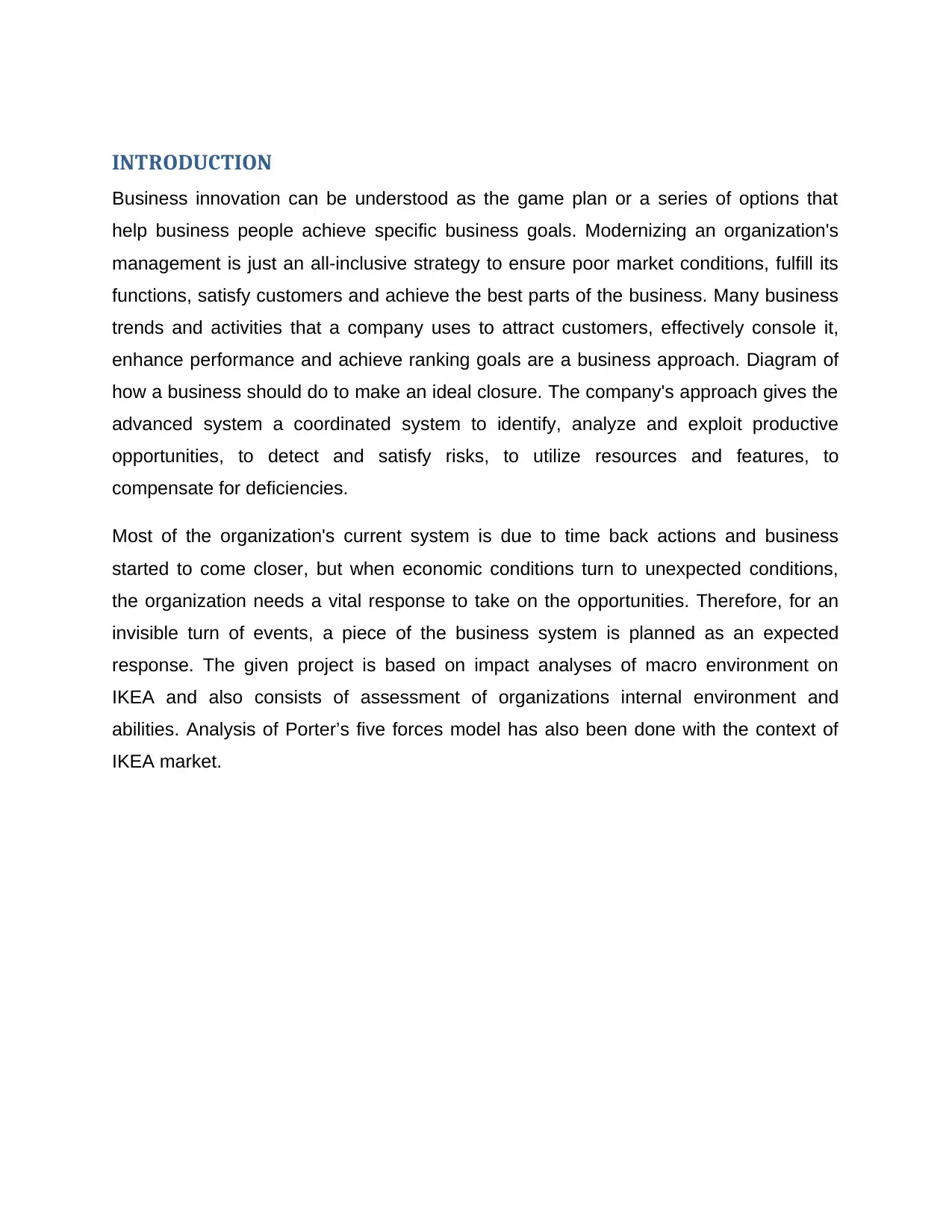
INTRODUCTION
Business innovation can be understood as the game plan or a series of options that
help business people achieve specific business goals. Modernizing an organization's
management is just an all-inclusive strategy to ensure poor market conditions, fulfill its
functions, satisfy customers and achieve the best parts of the business. Many business
trends and activities that a company uses to attract customers, effectively console it,
enhance performance and achieve ranking goals are a business approach. Diagram of
how a business should do to make an ideal closure. The company's approach gives the
advanced system a coordinated system to identify, analyze and exploit productive
opportunities, to detect and satisfy risks, to utilize resources and features, to
compensate for deficiencies.
Most of the organization's current system is due to time back actions and business
started to come closer, but when economic conditions turn to unexpected conditions,
the organization needs a vital response to take on the opportunities. Therefore, for an
invisible turn of events, a piece of the business system is planned as an expected
response. The given project is based on impact analyses of macro environment on
IKEA and also consists of assessment of organizations internal environment and
abilities. Analysis of Porter’s five forces model has also been done with the context of
IKEA market.
Business innovation can be understood as the game plan or a series of options that
help business people achieve specific business goals. Modernizing an organization's
management is just an all-inclusive strategy to ensure poor market conditions, fulfill its
functions, satisfy customers and achieve the best parts of the business. Many business
trends and activities that a company uses to attract customers, effectively console it,
enhance performance and achieve ranking goals are a business approach. Diagram of
how a business should do to make an ideal closure. The company's approach gives the
advanced system a coordinated system to identify, analyze and exploit productive
opportunities, to detect and satisfy risks, to utilize resources and features, to
compensate for deficiencies.
Most of the organization's current system is due to time back actions and business
started to come closer, but when economic conditions turn to unexpected conditions,
the organization needs a vital response to take on the opportunities. Therefore, for an
invisible turn of events, a piece of the business system is planned as an expected
response. The given project is based on impact analyses of macro environment on
IKEA and also consists of assessment of organizations internal environment and
abilities. Analysis of Porter’s five forces model has also been done with the context of
IKEA market.
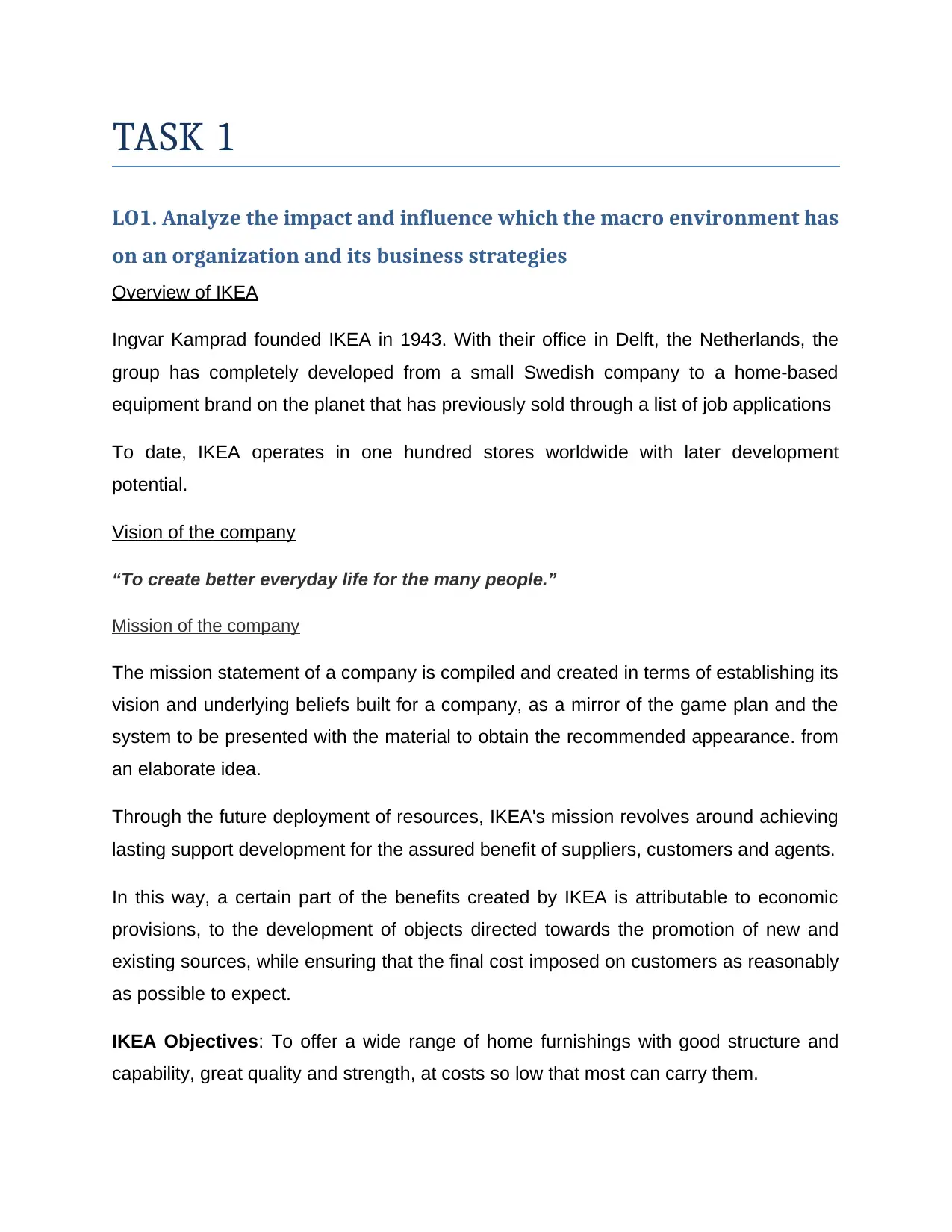
TASK 1
LO1. Analyze the impact and influence which the macro environment has
on an organization and its business strategies
Overview of IKEA
Ingvar Kamprad founded IKEA in 1943. With their office in Delft, the Netherlands, the
group has completely developed from a small Swedish company to a home-based
equipment brand on the planet that has previously sold through a list of job applications
To date, IKEA operates in one hundred stores worldwide with later development
potential.
Vision of the company
“To create better everyday life for the many people.”
Mission of the company
The mission statement of a company is compiled and created in terms of establishing its
vision and underlying beliefs built for a company, as a mirror of the game plan and the
system to be presented with the material to obtain the recommended appearance. from
an elaborate idea.
Through the future deployment of resources, IKEA's mission revolves around achieving
lasting support development for the assured benefit of suppliers, customers and agents.
In this way, a certain part of the benefits created by IKEA is attributable to economic
provisions, to the development of objects directed towards the promotion of new and
existing sources, while ensuring that the final cost imposed on customers as reasonably
as possible to expect.
IKEA Objectives: To offer a wide range of home furnishings with good structure and
capability, great quality and strength, at costs so low that most can carry them.
LO1. Analyze the impact and influence which the macro environment has
on an organization and its business strategies
Overview of IKEA
Ingvar Kamprad founded IKEA in 1943. With their office in Delft, the Netherlands, the
group has completely developed from a small Swedish company to a home-based
equipment brand on the planet that has previously sold through a list of job applications
To date, IKEA operates in one hundred stores worldwide with later development
potential.
Vision of the company
“To create better everyday life for the many people.”
Mission of the company
The mission statement of a company is compiled and created in terms of establishing its
vision and underlying beliefs built for a company, as a mirror of the game plan and the
system to be presented with the material to obtain the recommended appearance. from
an elaborate idea.
Through the future deployment of resources, IKEA's mission revolves around achieving
lasting support development for the assured benefit of suppliers, customers and agents.
In this way, a certain part of the benefits created by IKEA is attributable to economic
provisions, to the development of objects directed towards the promotion of new and
existing sources, while ensuring that the final cost imposed on customers as reasonably
as possible to expect.
IKEA Objectives: To offer a wide range of home furnishings with good structure and
capability, great quality and strength, at costs so low that most can carry them.
Secure Best Marks with AI Grader
Need help grading? Try our AI Grader for instant feedback on your assignments.
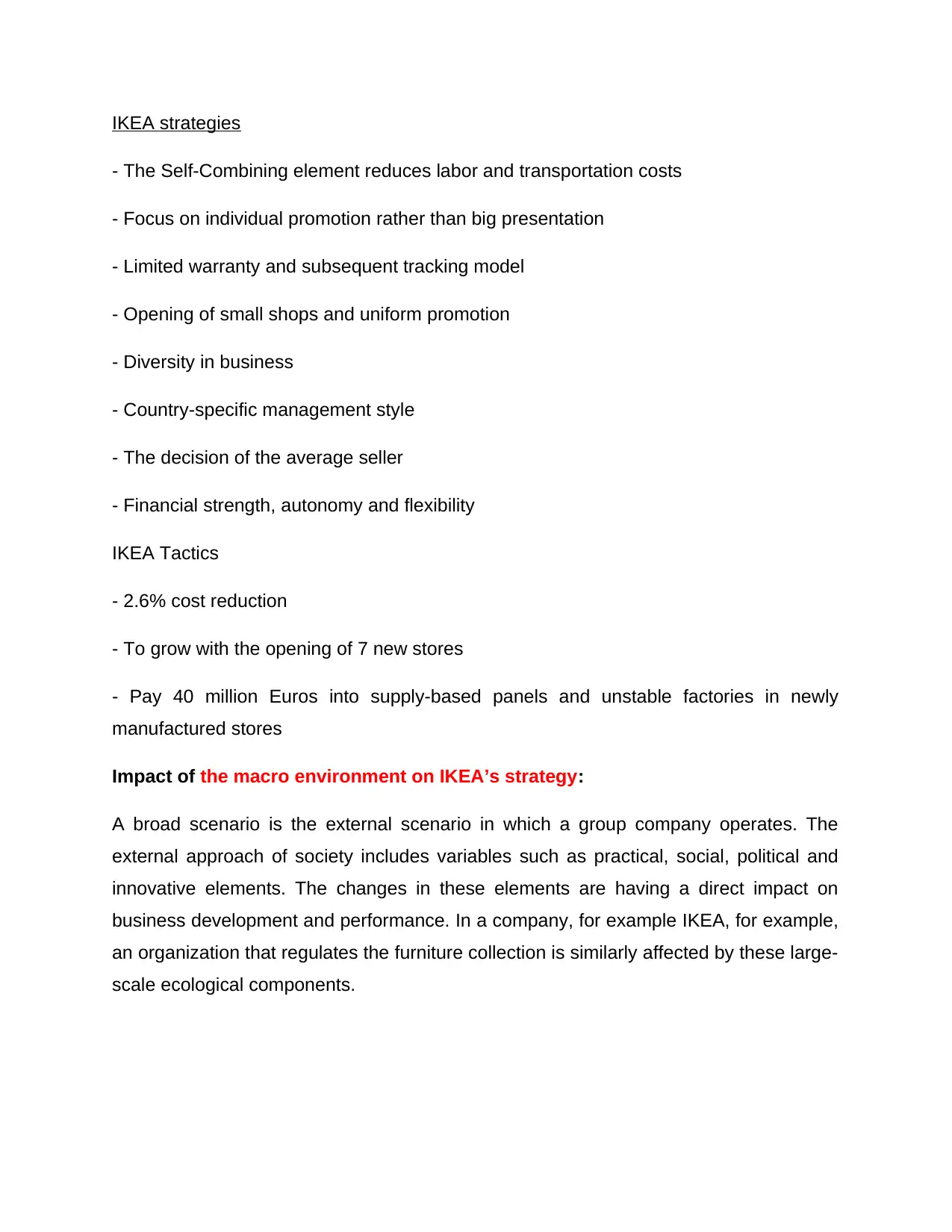
IKEA strategies
- The Self-Combining element reduces labor and transportation costs
- Focus on individual promotion rather than big presentation
- Limited warranty and subsequent tracking model
- Opening of small shops and uniform promotion
- Diversity in business
- Country-specific management style
- The decision of the average seller
- Financial strength, autonomy and flexibility
IKEA Tactics
- 2.6% cost reduction
- To grow with the opening of 7 new stores
- Pay 40 million Euros into supply-based panels and unstable factories in newly
manufactured stores
Impact of the macro environment on IKEA’s strategy:
A broad scenario is the external scenario in which a group company operates. The
external approach of society includes variables such as practical, social, political and
innovative elements. The changes in these elements are having a direct impact on
business development and performance. In a company, for example IKEA, for example,
an organization that regulates the furniture collection is similarly affected by these large-
scale ecological components.
- The Self-Combining element reduces labor and transportation costs
- Focus on individual promotion rather than big presentation
- Limited warranty and subsequent tracking model
- Opening of small shops and uniform promotion
- Diversity in business
- Country-specific management style
- The decision of the average seller
- Financial strength, autonomy and flexibility
IKEA Tactics
- 2.6% cost reduction
- To grow with the opening of 7 new stores
- Pay 40 million Euros into supply-based panels and unstable factories in newly
manufactured stores
Impact of the macro environment on IKEA’s strategy:
A broad scenario is the external scenario in which a group company operates. The
external approach of society includes variables such as practical, social, political and
innovative elements. The changes in these elements are having a direct impact on
business development and performance. In a company, for example IKEA, for example,
an organization that regulates the furniture collection is similarly affected by these large-
scale ecological components.
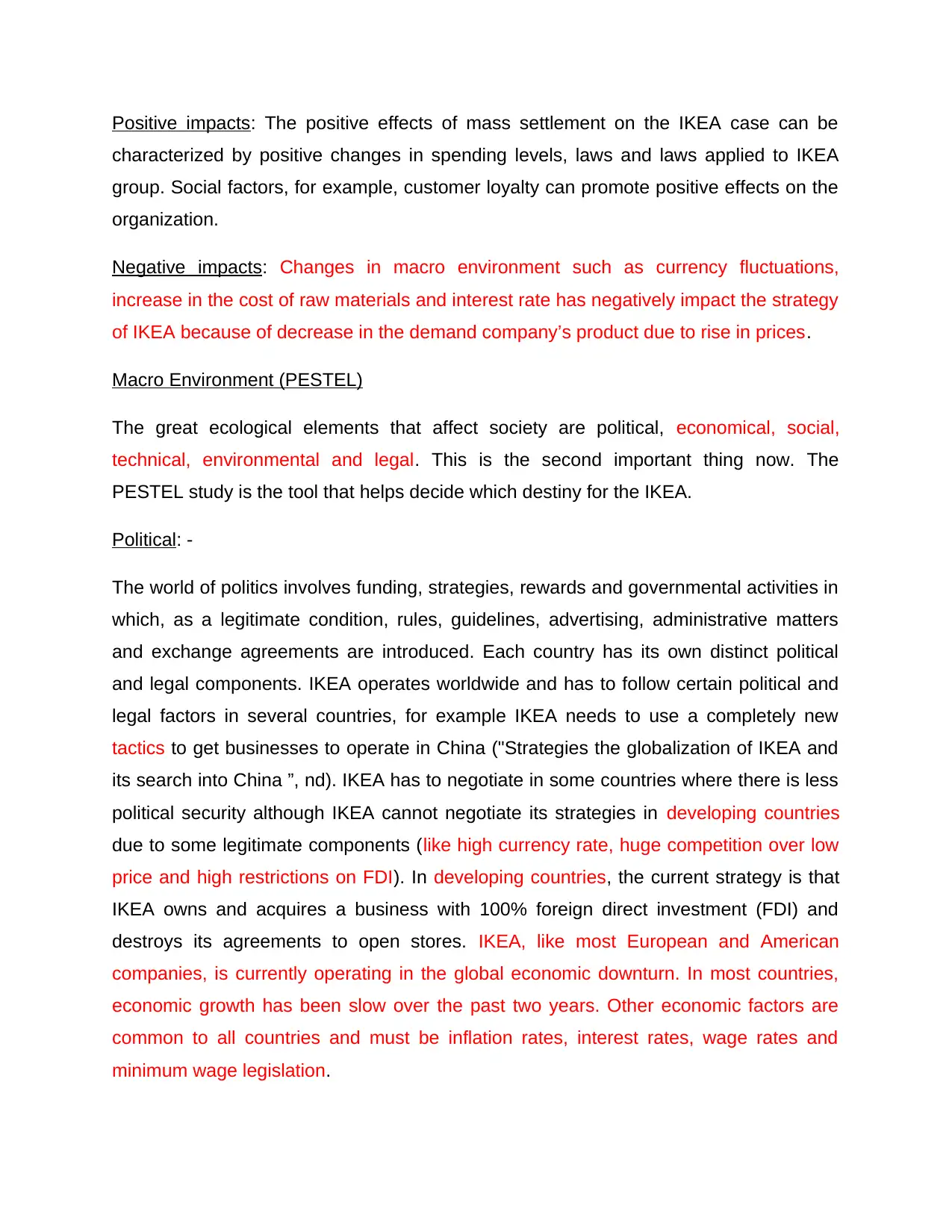
Positive impacts: The positive effects of mass settlement on the IKEA case can be
characterized by positive changes in spending levels, laws and laws applied to IKEA
group. Social factors, for example, customer loyalty can promote positive effects on the
organization.
Negative impacts: Changes in macro environment such as currency fluctuations,
increase in the cost of raw materials and interest rate has negatively impact the strategy
of IKEA because of decrease in the demand company’s product due to rise in prices.
Macro Environment (PESTEL)
The great ecological elements that affect society are political, economical, social,
technical, environmental and legal. This is the second important thing now. The
PESTEL study is the tool that helps decide which destiny for the IKEA.
Political: -
The world of politics involves funding, strategies, rewards and governmental activities in
which, as a legitimate condition, rules, guidelines, advertising, administrative matters
and exchange agreements are introduced. Each country has its own distinct political
and legal components. IKEA operates worldwide and has to follow certain political and
legal factors in several countries, for example IKEA needs to use a completely new
tactics to get businesses to operate in China ("Strategies the globalization of IKEA and
its search into China ”, nd). IKEA has to negotiate in some countries where there is less
political security although IKEA cannot negotiate its strategies in developing countries
due to some legitimate components (like high currency rate, huge competition over low
price and high restrictions on FDI). In developing countries, the current strategy is that
IKEA owns and acquires a business with 100% foreign direct investment (FDI) and
destroys its agreements to open stores. IKEA, like most European and American
companies, is currently operating in the global economic downturn. In most countries,
economic growth has been slow over the past two years. Other economic factors are
common to all countries and must be inflation rates, interest rates, wage rates and
minimum wage legislation.
characterized by positive changes in spending levels, laws and laws applied to IKEA
group. Social factors, for example, customer loyalty can promote positive effects on the
organization.
Negative impacts: Changes in macro environment such as currency fluctuations,
increase in the cost of raw materials and interest rate has negatively impact the strategy
of IKEA because of decrease in the demand company’s product due to rise in prices.
Macro Environment (PESTEL)
The great ecological elements that affect society are political, economical, social,
technical, environmental and legal. This is the second important thing now. The
PESTEL study is the tool that helps decide which destiny for the IKEA.
Political: -
The world of politics involves funding, strategies, rewards and governmental activities in
which, as a legitimate condition, rules, guidelines, advertising, administrative matters
and exchange agreements are introduced. Each country has its own distinct political
and legal components. IKEA operates worldwide and has to follow certain political and
legal factors in several countries, for example IKEA needs to use a completely new
tactics to get businesses to operate in China ("Strategies the globalization of IKEA and
its search into China ”, nd). IKEA has to negotiate in some countries where there is less
political security although IKEA cannot negotiate its strategies in developing countries
due to some legitimate components (like high currency rate, huge competition over low
price and high restrictions on FDI). In developing countries, the current strategy is that
IKEA owns and acquires a business with 100% foreign direct investment (FDI) and
destroys its agreements to open stores. IKEA, like most European and American
companies, is currently operating in the global economic downturn. In most countries,
economic growth has been slow over the past two years. Other economic factors are
common to all countries and must be inflation rates, interest rates, wage rates and
minimum wage legislation.
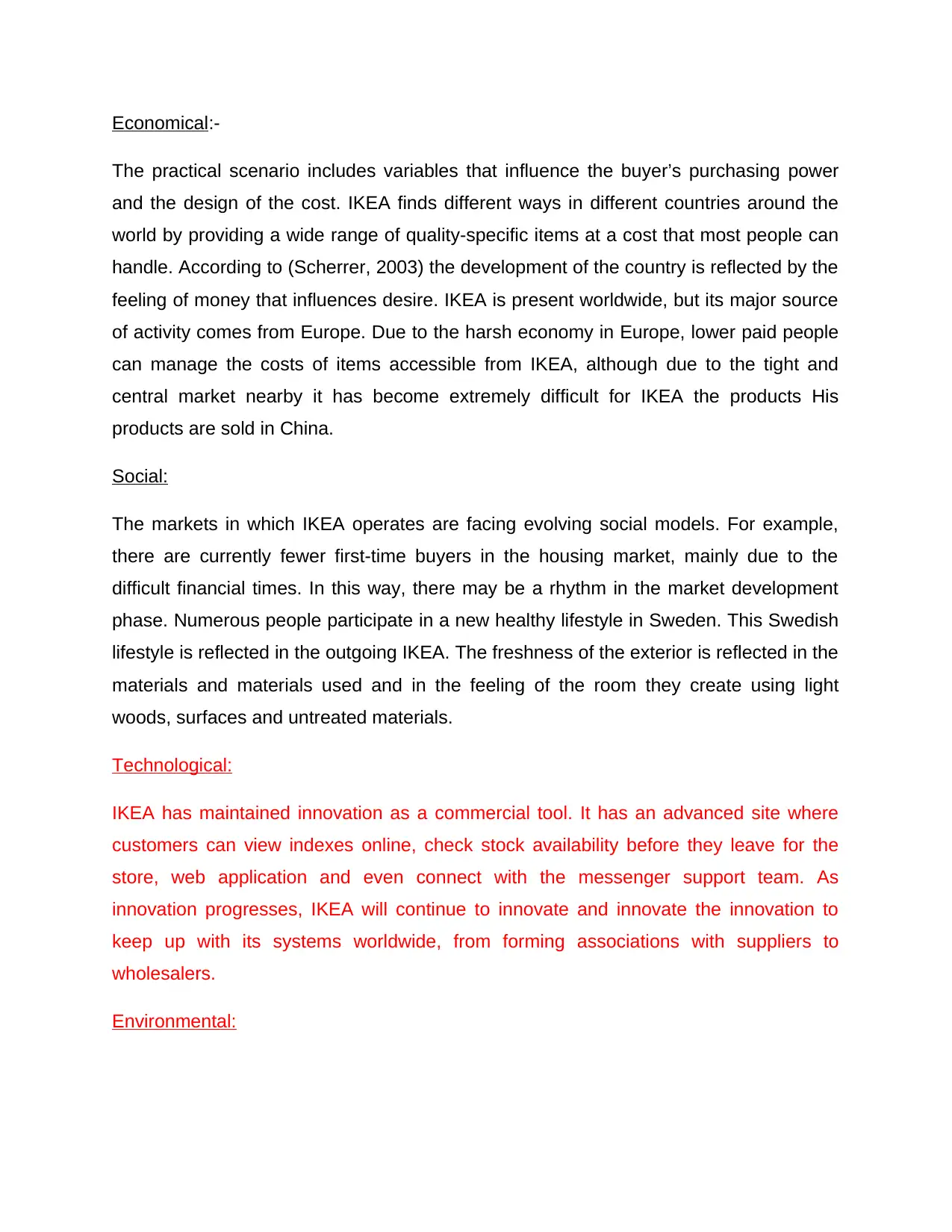
Economical:-
The practical scenario includes variables that influence the buyer’s purchasing power
and the design of the cost. IKEA finds different ways in different countries around the
world by providing a wide range of quality-specific items at a cost that most people can
handle. According to (Scherrer, 2003) the development of the country is reflected by the
feeling of money that influences desire. IKEA is present worldwide, but its major source
of activity comes from Europe. Due to the harsh economy in Europe, lower paid people
can manage the costs of items accessible from IKEA, although due to the tight and
central market nearby it has become extremely difficult for IKEA the products His
products are sold in China.
Social:
The markets in which IKEA operates are facing evolving social models. For example,
there are currently fewer first-time buyers in the housing market, mainly due to the
difficult financial times. In this way, there may be a rhythm in the market development
phase. Numerous people participate in a new healthy lifestyle in Sweden. This Swedish
lifestyle is reflected in the outgoing IKEA. The freshness of the exterior is reflected in the
materials and materials used and in the feeling of the room they create using light
woods, surfaces and untreated materials.
Technological:
IKEA has maintained innovation as a commercial tool. It has an advanced site where
customers can view indexes online, check stock availability before they leave for the
store, web application and even connect with the messenger support team. As
innovation progresses, IKEA will continue to innovate and innovate the innovation to
keep up with its systems worldwide, from forming associations with suppliers to
wholesalers.
Environmental:
The practical scenario includes variables that influence the buyer’s purchasing power
and the design of the cost. IKEA finds different ways in different countries around the
world by providing a wide range of quality-specific items at a cost that most people can
handle. According to (Scherrer, 2003) the development of the country is reflected by the
feeling of money that influences desire. IKEA is present worldwide, but its major source
of activity comes from Europe. Due to the harsh economy in Europe, lower paid people
can manage the costs of items accessible from IKEA, although due to the tight and
central market nearby it has become extremely difficult for IKEA the products His
products are sold in China.
Social:
The markets in which IKEA operates are facing evolving social models. For example,
there are currently fewer first-time buyers in the housing market, mainly due to the
difficult financial times. In this way, there may be a rhythm in the market development
phase. Numerous people participate in a new healthy lifestyle in Sweden. This Swedish
lifestyle is reflected in the outgoing IKEA. The freshness of the exterior is reflected in the
materials and materials used and in the feeling of the room they create using light
woods, surfaces and untreated materials.
Technological:
IKEA has maintained innovation as a commercial tool. It has an advanced site where
customers can view indexes online, check stock availability before they leave for the
store, web application and even connect with the messenger support team. As
innovation progresses, IKEA will continue to innovate and innovate the innovation to
keep up with its systems worldwide, from forming associations with suppliers to
wholesalers.
Environmental:
Paraphrase This Document
Need a fresh take? Get an instant paraphrase of this document with our AI Paraphraser

Since its inception, IKEA has been respectful of nature, which has led it to use both raw
materials and energy. This reduces costs and allows the organization to achieve its
green goals and has an overall positive impact on nature.
Legal:
IKEA is a worldwide company. This means that it is subject to several laws and laws in
different countries. This represents a risk where IKEA will not be able to control
principles and quality in certain areas where IKEA articles are the area where there is
no guidance for examining working conditions.
Critical analyses of impact of macro environment on IKEA
Comparing the major natural elements of IKEA using the PESTEL study shows that
IKEA has achieved great results by getting new modifications upon request. IKEA
shows how they tracked everything around the effective downturn that paints a strong
picture of the society. IKEA is facing all of its natural features before entering the
Chinese market, but it got the right strategies and demonstrated how they have
progressed in China. In six years of IKEA experience they have experienced several
setbacks, but the organization has remained firm and focused on its strategies and
overcome all obstacles that have occurred regardless of whether be they political,
economic, social, legal, mechanical or natural.
materials and energy. This reduces costs and allows the organization to achieve its
green goals and has an overall positive impact on nature.
Legal:
IKEA is a worldwide company. This means that it is subject to several laws and laws in
different countries. This represents a risk where IKEA will not be able to control
principles and quality in certain areas where IKEA articles are the area where there is
no guidance for examining working conditions.
Critical analyses of impact of macro environment on IKEA
Comparing the major natural elements of IKEA using the PESTEL study shows that
IKEA has achieved great results by getting new modifications upon request. IKEA
shows how they tracked everything around the effective downturn that paints a strong
picture of the society. IKEA is facing all of its natural features before entering the
Chinese market, but it got the right strategies and demonstrated how they have
progressed in China. In six years of IKEA experience they have experienced several
setbacks, but the organization has remained firm and focused on its strategies and
overcome all obstacles that have occurred regardless of whether be they political,
economic, social, legal, mechanical or natural.

TASK 2
LO2. Critically evaluating the internal environment and capabilities
The VRIO framework is a tool that evaluates an organization's merits and shortcomings.
The system is organized in the progression of four surveys to be carried out on
company exercises. These four investigations concern value, irregularity, limitability and
relationship. These investigations are summarized in the following figure.
LO2. Critically evaluating the internal environment and capabilities
The VRIO framework is a tool that evaluates an organization's merits and shortcomings.
The system is organized in the progression of four surveys to be carried out on
company exercises. These four investigations concern value, irregularity, limitability and
relationship. These investigations are summarized in the following figure.
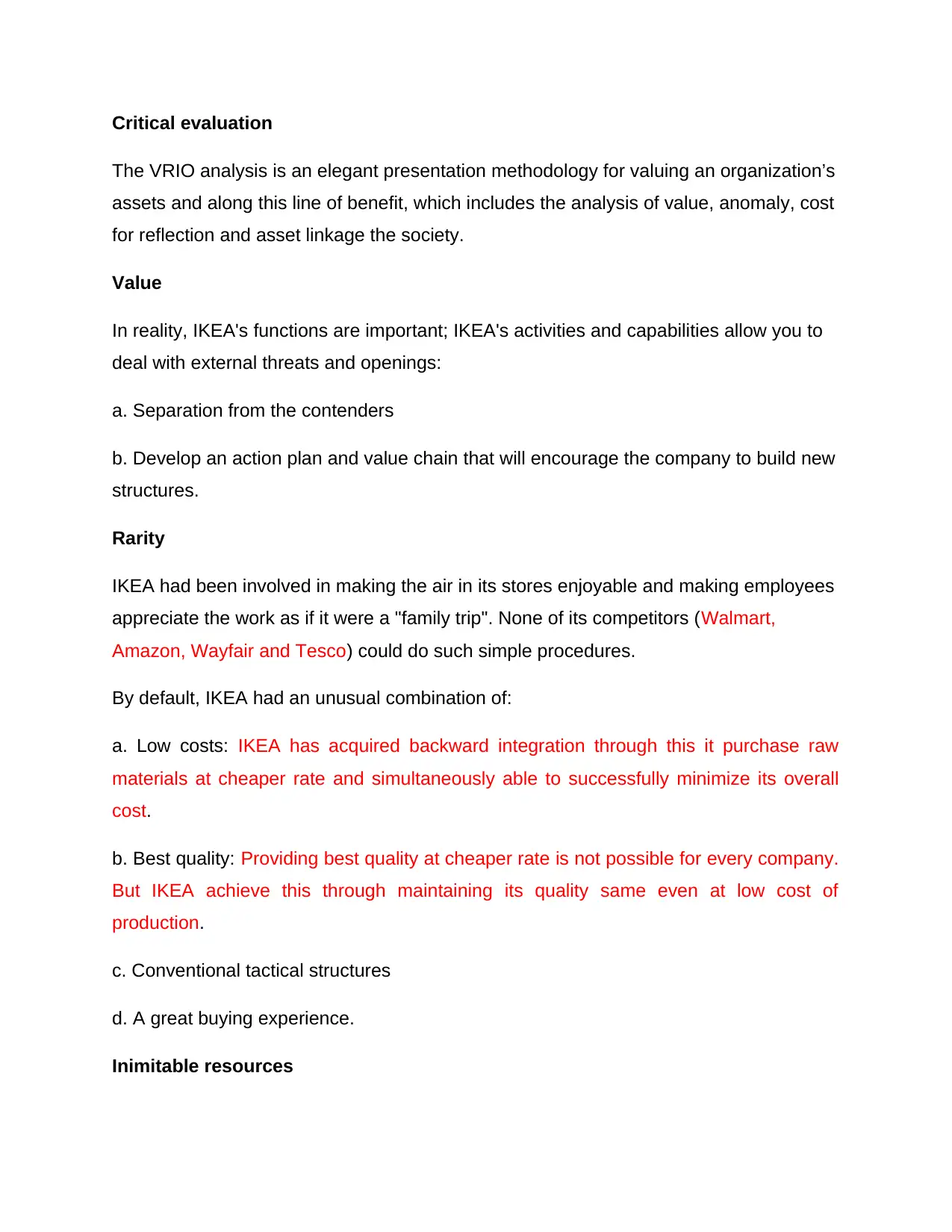
Critical evaluation
The VRIO analysis is an elegant presentation methodology for valuing an organization’s
assets and along this line of benefit, which includes the analysis of value, anomaly, cost
for reflection and asset linkage the society.
Value
In reality, IKEA's functions are important; IKEA's activities and capabilities allow you to
deal with external threats and openings:
a. Separation from the contenders
b. Develop an action plan and value chain that will encourage the company to build new
structures.
Rarity
IKEA had been involved in making the air in its stores enjoyable and making employees
appreciate the work as if it were a "family trip". None of its competitors (Walmart,
Amazon, Wayfair and Tesco) could do such simple procedures.
By default, IKEA had an unusual combination of:
a. Low costs: IKEA has acquired backward integration through this it purchase raw
materials at cheaper rate and simultaneously able to successfully minimize its overall
cost.
b. Best quality: Providing best quality at cheaper rate is not possible for every company.
But IKEA achieve this through maintaining its quality same even at low cost of
production.
c. Conventional tactical structures
d. A great buying experience.
Inimitable resources
The VRIO analysis is an elegant presentation methodology for valuing an organization’s
assets and along this line of benefit, which includes the analysis of value, anomaly, cost
for reflection and asset linkage the society.
Value
In reality, IKEA's functions are important; IKEA's activities and capabilities allow you to
deal with external threats and openings:
a. Separation from the contenders
b. Develop an action plan and value chain that will encourage the company to build new
structures.
Rarity
IKEA had been involved in making the air in its stores enjoyable and making employees
appreciate the work as if it were a "family trip". None of its competitors (Walmart,
Amazon, Wayfair and Tesco) could do such simple procedures.
By default, IKEA had an unusual combination of:
a. Low costs: IKEA has acquired backward integration through this it purchase raw
materials at cheaper rate and simultaneously able to successfully minimize its overall
cost.
b. Best quality: Providing best quality at cheaper rate is not possible for every company.
But IKEA achieve this through maintaining its quality same even at low cost of
production.
c. Conventional tactical structures
d. A great buying experience.
Inimitable resources
Secure Best Marks with AI Grader
Need help grading? Try our AI Grader for instant feedback on your assignments.

Difficult to imitate or temporarily update the IKEA model, IKEA will always be the
pioneer and the competitors behind it due to its eagerness to learn, adapt and
experience. The various controversies that require reporting on the organization model
should have the initiative, the efforts, the time and the most important thing that the
administration needs.
Organization
Because IKEA has been in mobile advertising for a long time with its proximity to
several countries, so has:
a. The understanding and skill required,
b. The profitability required
The best use of its assets and capabilities.
Resource based view for competitive analysis:
IKEA is compared with other resource-based view companies (eg Starbucks, H&M and
Body Shop). Replacing so many organizations represented here is a real customer
experience. Unparalleled messenger respect depends on meetings of great help, solid
branding and dynamic communication that emerge from it. This needs to be as close to
customers, an understanding of the pre-requisites and the methods of furniture that suit
their features and lifestyles. Getting from (and with) customers in different ways is
crucial if an organization wants to stay customer focused.
The social and natural responsibility of enterprises has been shown to be fruitful, both
now and in the long term. Imaginative help ideas that use physical elements such as
management standards and customer meetings can use motivation. Quality logic and
logic of important value are harmonious, fruitful and sustainable.
After a survey on the PORTERS system value chain, information is provided on what
makes IKEA a pioneer among its competitors. The one-of-a-kind plan and the least
effort of an object reduce the agent and new participants. The key to selling their
products is their quality of minimal effort due to a strong relationship with suppliers and
pioneer and the competitors behind it due to its eagerness to learn, adapt and
experience. The various controversies that require reporting on the organization model
should have the initiative, the efforts, the time and the most important thing that the
administration needs.
Organization
Because IKEA has been in mobile advertising for a long time with its proximity to
several countries, so has:
a. The understanding and skill required,
b. The profitability required
The best use of its assets and capabilities.
Resource based view for competitive analysis:
IKEA is compared with other resource-based view companies (eg Starbucks, H&M and
Body Shop). Replacing so many organizations represented here is a real customer
experience. Unparalleled messenger respect depends on meetings of great help, solid
branding and dynamic communication that emerge from it. This needs to be as close to
customers, an understanding of the pre-requisites and the methods of furniture that suit
their features and lifestyles. Getting from (and with) customers in different ways is
crucial if an organization wants to stay customer focused.
The social and natural responsibility of enterprises has been shown to be fruitful, both
now and in the long term. Imaginative help ideas that use physical elements such as
management standards and customer meetings can use motivation. Quality logic and
logic of important value are harmonious, fruitful and sustainable.
After a survey on the PORTERS system value chain, information is provided on what
makes IKEA a pioneer among its competitors. The one-of-a-kind plan and the least
effort of an object reduce the agent and new participants. The key to selling their
products is their quality of minimal effort due to a strong relationship with suppliers and
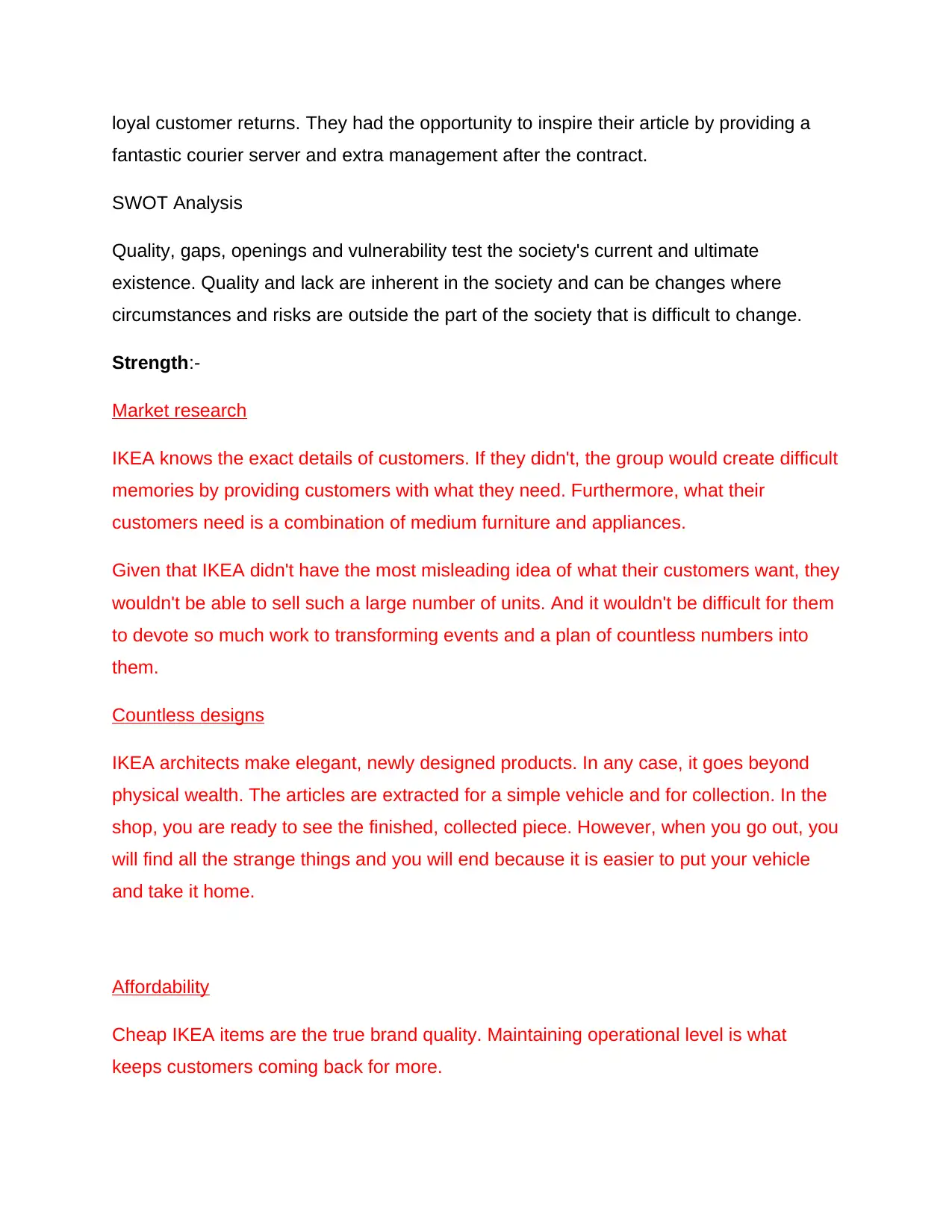
loyal customer returns. They had the opportunity to inspire their article by providing a
fantastic courier server and extra management after the contract.
SWOT Analysis
Quality, gaps, openings and vulnerability test the society's current and ultimate
existence. Quality and lack are inherent in the society and can be changes where
circumstances and risks are outside the part of the society that is difficult to change.
Strength:-
Market research
IKEA knows the exact details of customers. If they didn't, the group would create difficult
memories by providing customers with what they need. Furthermore, what their
customers need is a combination of medium furniture and appliances.
Given that IKEA didn't have the most misleading idea of what their customers want, they
wouldn't be able to sell such a large number of units. And it wouldn't be difficult for them
to devote so much work to transforming events and a plan of countless numbers into
them.
Countless designs
IKEA architects make elegant, newly designed products. In any case, it goes beyond
physical wealth. The articles are extracted for a simple vehicle and for collection. In the
shop, you are ready to see the finished, collected piece. However, when you go out, you
will find all the strange things and you will end because it is easier to put your vehicle
and take it home.
Affordability
Cheap IKEA items are the true brand quality. Maintaining operational level is what
keeps customers coming back for more.
fantastic courier server and extra management after the contract.
SWOT Analysis
Quality, gaps, openings and vulnerability test the society's current and ultimate
existence. Quality and lack are inherent in the society and can be changes where
circumstances and risks are outside the part of the society that is difficult to change.
Strength:-
Market research
IKEA knows the exact details of customers. If they didn't, the group would create difficult
memories by providing customers with what they need. Furthermore, what their
customers need is a combination of medium furniture and appliances.
Given that IKEA didn't have the most misleading idea of what their customers want, they
wouldn't be able to sell such a large number of units. And it wouldn't be difficult for them
to devote so much work to transforming events and a plan of countless numbers into
them.
Countless designs
IKEA architects make elegant, newly designed products. In any case, it goes beyond
physical wealth. The articles are extracted for a simple vehicle and for collection. In the
shop, you are ready to see the finished, collected piece. However, when you go out, you
will find all the strange things and you will end because it is easier to put your vehicle
and take it home.
Affordability
Cheap IKEA items are the true brand quality. Maintaining operational level is what
keeps customers coming back for more.
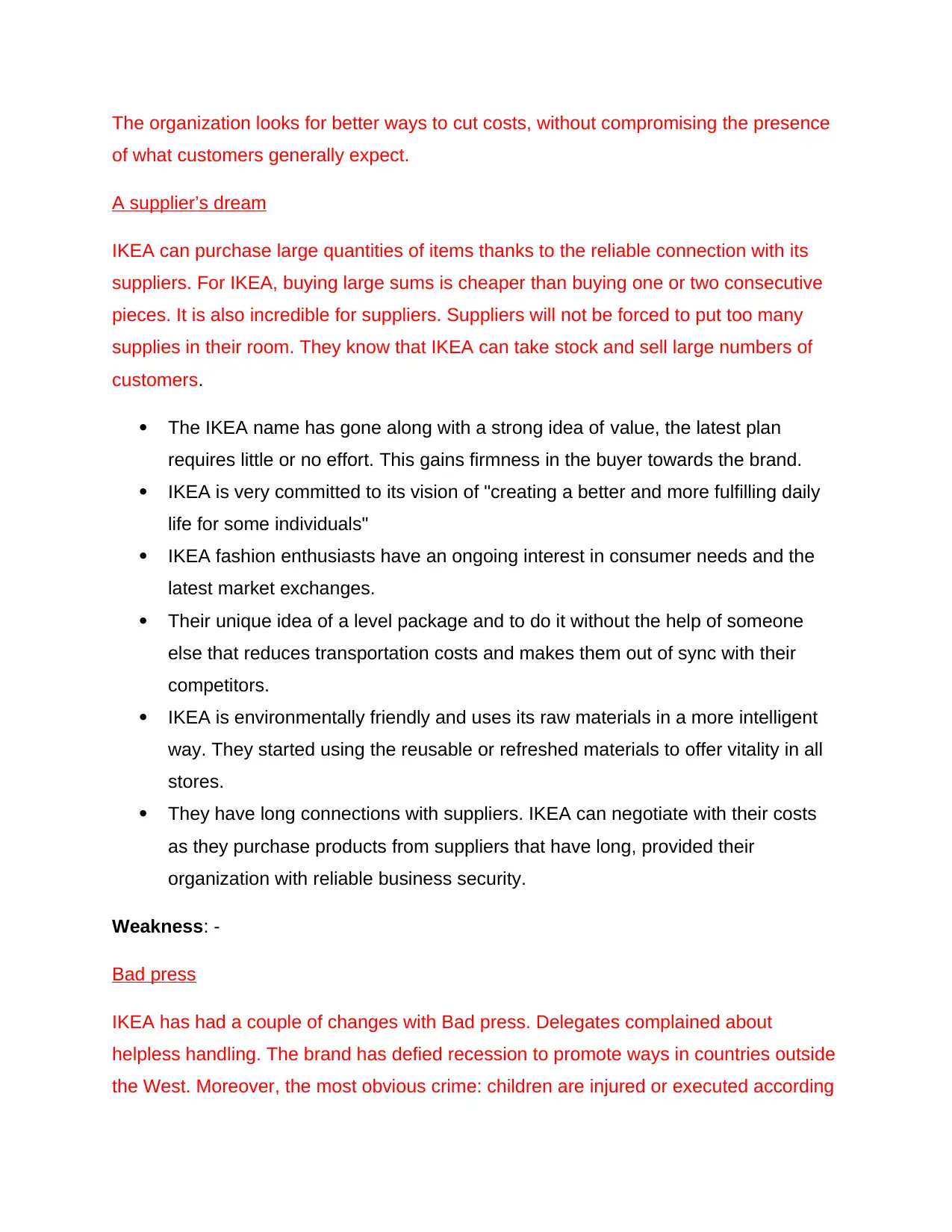
The organization looks for better ways to cut costs, without compromising the presence
of what customers generally expect.
A supplier’s dream
IKEA can purchase large quantities of items thanks to the reliable connection with its
suppliers. For IKEA, buying large sums is cheaper than buying one or two consecutive
pieces. It is also incredible for suppliers. Suppliers will not be forced to put too many
supplies in their room. They know that IKEA can take stock and sell large numbers of
customers.
The IKEA name has gone along with a strong idea of value, the latest plan
requires little or no effort. This gains firmness in the buyer towards the brand.
IKEA is very committed to its vision of "creating a better and more fulfilling daily
life for some individuals"
IKEA fashion enthusiasts have an ongoing interest in consumer needs and the
latest market exchanges.
Their unique idea of a level package and to do it without the help of someone
else that reduces transportation costs and makes them out of sync with their
competitors.
IKEA is environmentally friendly and uses its raw materials in a more intelligent
way. They started using the reusable or refreshed materials to offer vitality in all
stores.
They have long connections with suppliers. IKEA can negotiate with their costs
as they purchase products from suppliers that have long, provided their
organization with reliable business security.
Weakness: -
Bad press
IKEA has had a couple of changes with Bad press. Delegates complained about
helpless handling. The brand has defied recession to promote ways in countries outside
the West. Moreover, the most obvious crime: children are injured or executed according
of what customers generally expect.
A supplier’s dream
IKEA can purchase large quantities of items thanks to the reliable connection with its
suppliers. For IKEA, buying large sums is cheaper than buying one or two consecutive
pieces. It is also incredible for suppliers. Suppliers will not be forced to put too many
supplies in their room. They know that IKEA can take stock and sell large numbers of
customers.
The IKEA name has gone along with a strong idea of value, the latest plan
requires little or no effort. This gains firmness in the buyer towards the brand.
IKEA is very committed to its vision of "creating a better and more fulfilling daily
life for some individuals"
IKEA fashion enthusiasts have an ongoing interest in consumer needs and the
latest market exchanges.
Their unique idea of a level package and to do it without the help of someone
else that reduces transportation costs and makes them out of sync with their
competitors.
IKEA is environmentally friendly and uses its raw materials in a more intelligent
way. They started using the reusable or refreshed materials to offer vitality in all
stores.
They have long connections with suppliers. IKEA can negotiate with their costs
as they purchase products from suppliers that have long, provided their
organization with reliable business security.
Weakness: -
Bad press
IKEA has had a couple of changes with Bad press. Delegates complained about
helpless handling. The brand has defied recession to promote ways in countries outside
the West. Moreover, the most obvious crime: children are injured or executed according
Paraphrase This Document
Need a fresh take? Get an instant paraphrase of this document with our AI Paraphraser
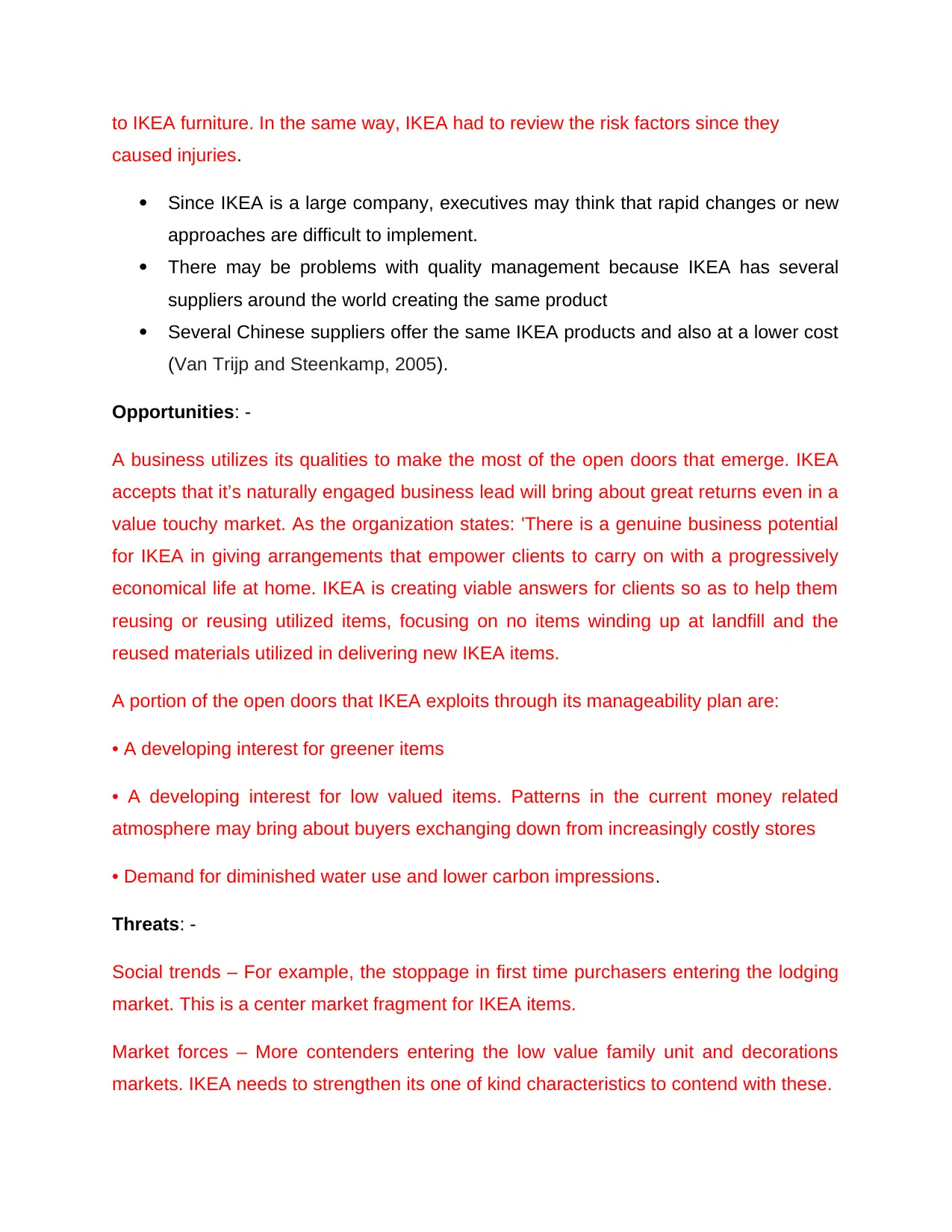
to IKEA furniture. In the same way, IKEA had to review the risk factors since they
caused injuries.
Since IKEA is a large company, executives may think that rapid changes or new
approaches are difficult to implement.
There may be problems with quality management because IKEA has several
suppliers around the world creating the same product
Several Chinese suppliers offer the same IKEA products and also at a lower cost
(Van Trijp and Steenkamp, 2005).
Opportunities: -
A business utilizes its qualities to make the most of the open doors that emerge. IKEA
accepts that it’s naturally engaged business lead will bring about great returns even in a
value touchy market. As the organization states: 'There is a genuine business potential
for IKEA in giving arrangements that empower clients to carry on with a progressively
economical life at home. IKEA is creating viable answers for clients so as to help them
reusing or reusing utilized items, focusing on no items winding up at landfill and the
reused materials utilized in delivering new IKEA items.
A portion of the open doors that IKEA exploits through its manageability plan are:
• A developing interest for greener items
• A developing interest for low valued items. Patterns in the current money related
atmosphere may bring about buyers exchanging down from increasingly costly stores
• Demand for diminished water use and lower carbon impressions.
Threats: -
Social trends – For example, the stoppage in first time purchasers entering the lodging
market. This is a center market fragment for IKEA items.
Market forces – More contenders entering the low value family unit and decorations
markets. IKEA needs to strengthen its one of kind characteristics to contend with these.
caused injuries.
Since IKEA is a large company, executives may think that rapid changes or new
approaches are difficult to implement.
There may be problems with quality management because IKEA has several
suppliers around the world creating the same product
Several Chinese suppliers offer the same IKEA products and also at a lower cost
(Van Trijp and Steenkamp, 2005).
Opportunities: -
A business utilizes its qualities to make the most of the open doors that emerge. IKEA
accepts that it’s naturally engaged business lead will bring about great returns even in a
value touchy market. As the organization states: 'There is a genuine business potential
for IKEA in giving arrangements that empower clients to carry on with a progressively
economical life at home. IKEA is creating viable answers for clients so as to help them
reusing or reusing utilized items, focusing on no items winding up at landfill and the
reused materials utilized in delivering new IKEA items.
A portion of the open doors that IKEA exploits through its manageability plan are:
• A developing interest for greener items
• A developing interest for low valued items. Patterns in the current money related
atmosphere may bring about buyers exchanging down from increasingly costly stores
• Demand for diminished water use and lower carbon impressions.
Threats: -
Social trends – For example, the stoppage in first time purchasers entering the lodging
market. This is a center market fragment for IKEA items.
Market forces – More contenders entering the low value family unit and decorations
markets. IKEA needs to strengthen its one of kind characteristics to contend with these.

Economic factors – The downturn hinders purchaser spending and extra cash
diminishes.
A SWOT survey study suggests that IKEA should continue to adapt to the market model
that may be indoors or in the distance. Quality and shortcomings are seen as an integral
part of the organization. IKEA can expand its strength in areas such as expanding its
range of objects and putting new creative ideas ahead of its competitors. The
vulnerability and openings is an external feature of the organization. To reduce the risk
of new market participants, IKEA needs to keep up to date with the latest innovations
and grow new items in line with customer needs. They should recognize modern
structures and try to extend the reach of their objects. IKEA can become increasingly
serious by compiling its articles in creating nations.
TASK 3
LO3. Evaluate and apply the outcomes of Porter’s five forces model
IKEA's competitive strategy using the PORTERS framework
Bargaining power of buyers: -
While the bargaining power of individual buyers is insignificant in case of IKEA, they will
have an emergency outlet as a collection and that is why there is so much prospect of
getting in and out retains customers. Customers from all businesses have been
increasingly involved in the 21st century. In addition to the extensive conflict,
mechanical development has brought about this change. Equality is currently in the
customer's favor ("IKEA Review", 2010).
Bargaining power of suppliers:-
The bargaining power of IKEA suppliers is low because while their number is large their
small size and weak financial position does not allow them enough opportunity.
Obviously IKEA can change by starting with one supplier and then with the next and if a
diminishes.
A SWOT survey study suggests that IKEA should continue to adapt to the market model
that may be indoors or in the distance. Quality and shortcomings are seen as an integral
part of the organization. IKEA can expand its strength in areas such as expanding its
range of objects and putting new creative ideas ahead of its competitors. The
vulnerability and openings is an external feature of the organization. To reduce the risk
of new market participants, IKEA needs to keep up to date with the latest innovations
and grow new items in line with customer needs. They should recognize modern
structures and try to extend the reach of their objects. IKEA can become increasingly
serious by compiling its articles in creating nations.
TASK 3
LO3. Evaluate and apply the outcomes of Porter’s five forces model
IKEA's competitive strategy using the PORTERS framework
Bargaining power of buyers: -
While the bargaining power of individual buyers is insignificant in case of IKEA, they will
have an emergency outlet as a collection and that is why there is so much prospect of
getting in and out retains customers. Customers from all businesses have been
increasingly involved in the 21st century. In addition to the extensive conflict,
mechanical development has brought about this change. Equality is currently in the
customer's favor ("IKEA Review", 2010).
Bargaining power of suppliers:-
The bargaining power of IKEA suppliers is low because while their number is large their
small size and weak financial position does not allow them enough opportunity.
Obviously IKEA can change by starting with one supplier and then with the next and if a
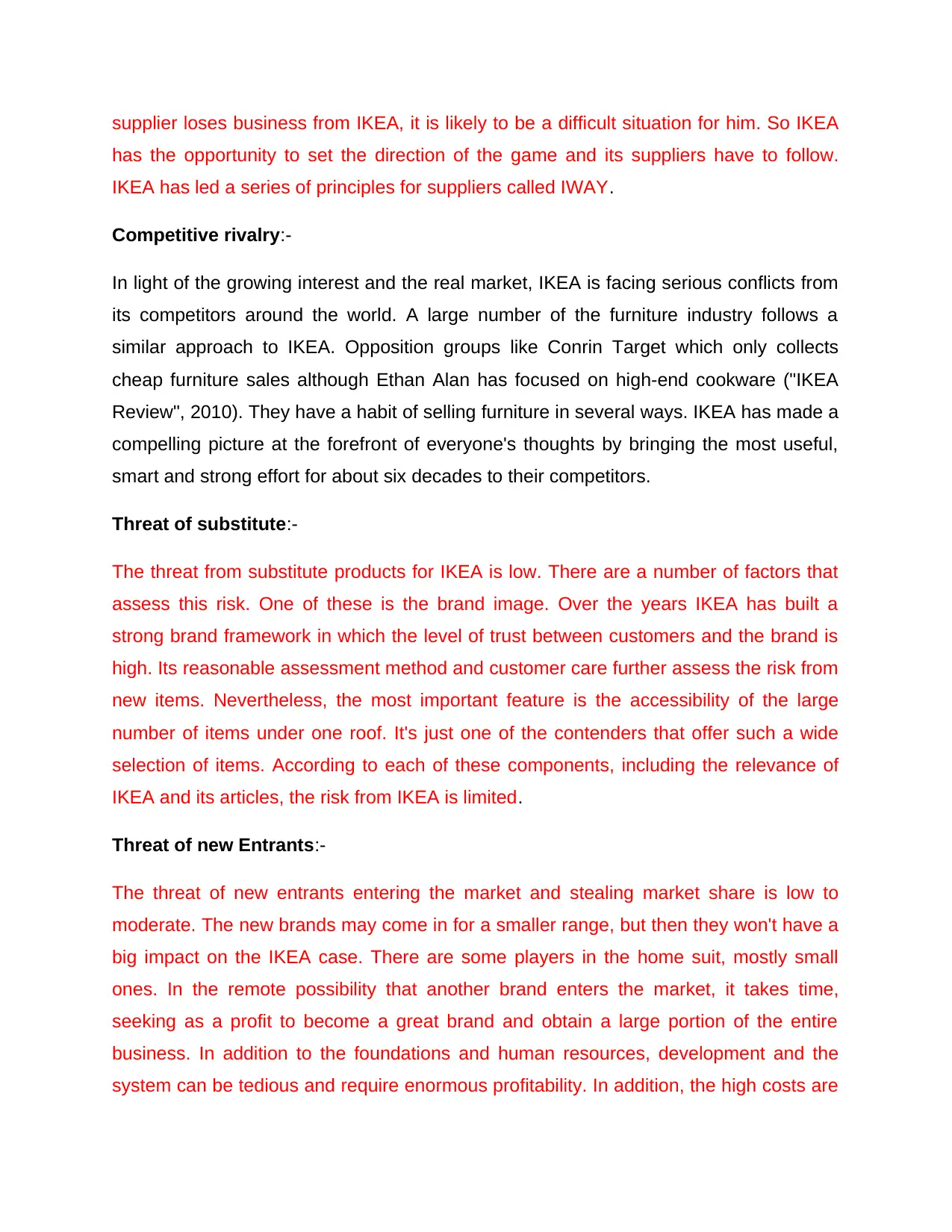
supplier loses business from IKEA, it is likely to be a difficult situation for him. So IKEA
has the opportunity to set the direction of the game and its suppliers have to follow.
IKEA has led a series of principles for suppliers called IWAY.
Competitive rivalry:-
In light of the growing interest and the real market, IKEA is facing serious conflicts from
its competitors around the world. A large number of the furniture industry follows a
similar approach to IKEA. Opposition groups like Conrin Target which only collects
cheap furniture sales although Ethan Alan has focused on high-end cookware ("IKEA
Review", 2010). They have a habit of selling furniture in several ways. IKEA has made a
compelling picture at the forefront of everyone's thoughts by bringing the most useful,
smart and strong effort for about six decades to their competitors.
Threat of substitute:-
The threat from substitute products for IKEA is low. There are a number of factors that
assess this risk. One of these is the brand image. Over the years IKEA has built a
strong brand framework in which the level of trust between customers and the brand is
high. Its reasonable assessment method and customer care further assess the risk from
new items. Nevertheless, the most important feature is the accessibility of the large
number of items under one roof. It's just one of the contenders that offer such a wide
selection of items. According to each of these components, including the relevance of
IKEA and its articles, the risk from IKEA is limited.
Threat of new Entrants:-
The threat of new entrants entering the market and stealing market share is low to
moderate. The new brands may come in for a smaller range, but then they won't have a
big impact on the IKEA case. There are some players in the home suit, mostly small
ones. In the remote possibility that another brand enters the market, it takes time,
seeking as a profit to become a great brand and obtain a large portion of the entire
business. In addition to the foundations and human resources, development and the
system can be tedious and require enormous profitability. In addition, the high costs are
has the opportunity to set the direction of the game and its suppliers have to follow.
IKEA has led a series of principles for suppliers called IWAY.
Competitive rivalry:-
In light of the growing interest and the real market, IKEA is facing serious conflicts from
its competitors around the world. A large number of the furniture industry follows a
similar approach to IKEA. Opposition groups like Conrin Target which only collects
cheap furniture sales although Ethan Alan has focused on high-end cookware ("IKEA
Review", 2010). They have a habit of selling furniture in several ways. IKEA has made a
compelling picture at the forefront of everyone's thoughts by bringing the most useful,
smart and strong effort for about six decades to their competitors.
Threat of substitute:-
The threat from substitute products for IKEA is low. There are a number of factors that
assess this risk. One of these is the brand image. Over the years IKEA has built a
strong brand framework in which the level of trust between customers and the brand is
high. Its reasonable assessment method and customer care further assess the risk from
new items. Nevertheless, the most important feature is the accessibility of the large
number of items under one roof. It's just one of the contenders that offer such a wide
selection of items. According to each of these components, including the relevance of
IKEA and its articles, the risk from IKEA is limited.
Threat of new Entrants:-
The threat of new entrants entering the market and stealing market share is low to
moderate. The new brands may come in for a smaller range, but then they won't have a
big impact on the IKEA case. There are some players in the home suit, mostly small
ones. In the remote possibility that another brand enters the market, it takes time,
seeking as a profit to become a great brand and obtain a large portion of the entire
business. In addition to the foundations and human resources, development and the
system can be tedious and require enormous profitability. In addition, the high costs are
Secure Best Marks with AI Grader
Need help grading? Try our AI Grader for instant feedback on your assignments.
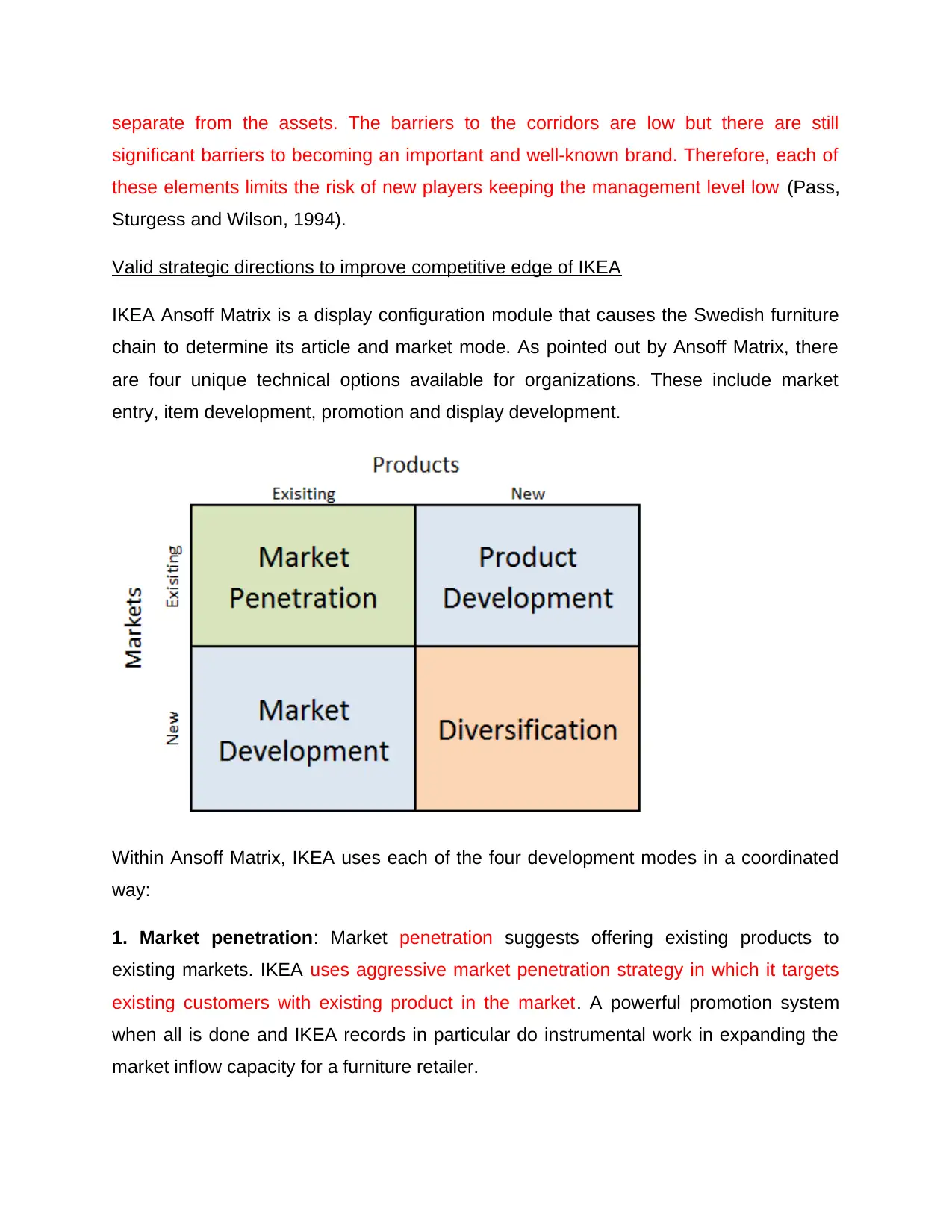
separate from the assets. The barriers to the corridors are low but there are still
significant barriers to becoming an important and well-known brand. Therefore, each of
these elements limits the risk of new players keeping the management level low (Pass,
Sturgess and Wilson, 1994).
Valid strategic directions to improve competitive edge of IKEA
IKEA Ansoff Matrix is a display configuration module that causes the Swedish furniture
chain to determine its article and market mode. As pointed out by Ansoff Matrix, there
are four unique technical options available for organizations. These include market
entry, item development, promotion and display development.
Within Ansoff Matrix, IKEA uses each of the four development modes in a coordinated
way:
1. Market penetration: Market penetration suggests offering existing products to
existing markets. IKEA uses aggressive market penetration strategy in which it targets
existing customers with existing product in the market. A powerful promotion system
when all is done and IKEA records in particular do instrumental work in expanding the
market inflow capacity for a furniture retailer.
significant barriers to becoming an important and well-known brand. Therefore, each of
these elements limits the risk of new players keeping the management level low (Pass,
Sturgess and Wilson, 1994).
Valid strategic directions to improve competitive edge of IKEA
IKEA Ansoff Matrix is a display configuration module that causes the Swedish furniture
chain to determine its article and market mode. As pointed out by Ansoff Matrix, there
are four unique technical options available for organizations. These include market
entry, item development, promotion and display development.
Within Ansoff Matrix, IKEA uses each of the four development modes in a coordinated
way:
1. Market penetration: Market penetration suggests offering existing products to
existing markets. IKEA uses aggressive market penetration strategy in which it targets
existing customers with existing product in the market. A powerful promotion system
when all is done and IKEA records in particular do instrumental work in expanding the
market inflow capacity for a furniture retailer.
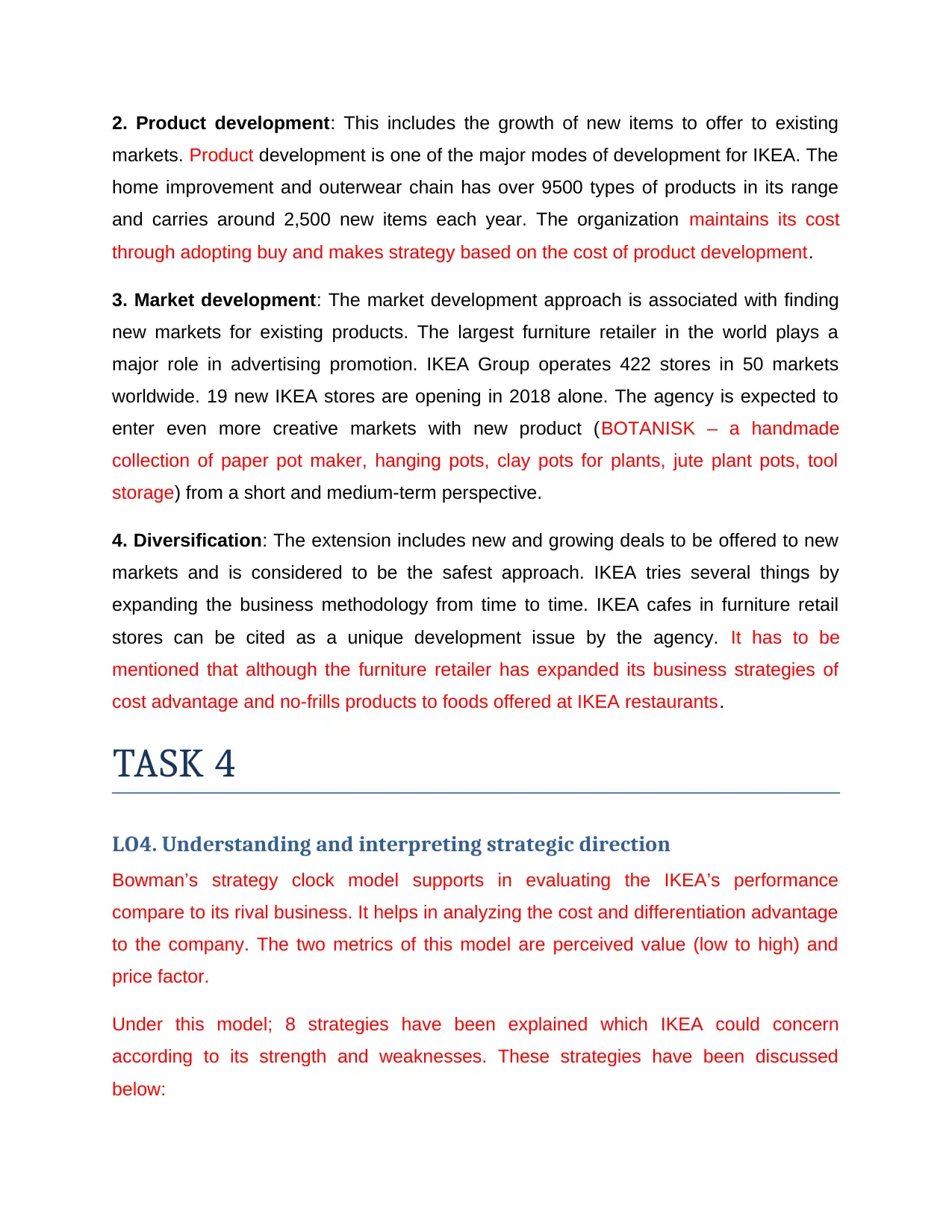
2. Product development: This includes the growth of new items to offer to existing
markets. Product development is one of the major modes of development for IKEA. The
home improvement and outerwear chain has over 9500 types of products in its range
and carries around 2,500 new items each year. The organization maintains its cost
through adopting buy and makes strategy based on the cost of product development.
3. Market development: The market development approach is associated with finding
new markets for existing products. The largest furniture retailer in the world plays a
major role in advertising promotion. IKEA Group operates 422 stores in 50 markets
worldwide. 19 new IKEA stores are opening in 2018 alone. The agency is expected to
enter even more creative markets with new product (BOTANISK – a handmade
collection of paper pot maker, hanging pots, clay pots for plants, jute plant pots, tool
storage) from a short and medium-term perspective.
4. Diversification: The extension includes new and growing deals to be offered to new
markets and is considered to be the safest approach. IKEA tries several things by
expanding the business methodology from time to time. IKEA cafes in furniture retail
stores can be cited as a unique development issue by the agency. It has to be
mentioned that although the furniture retailer has expanded its business strategies of
cost advantage and no-frills products to foods offered at IKEA restaurants.
TASK 4
LO4. Understanding and interpreting strategic direction
Bowman’s strategy clock model supports in evaluating the IKEA’s performance
compare to its rival business. It helps in analyzing the cost and differentiation advantage
to the company. The two metrics of this model are perceived value (low to high) and
price factor.
Under this model; 8 strategies have been explained which IKEA could concern
according to its strength and weaknesses. These strategies have been discussed
below:
markets. Product development is one of the major modes of development for IKEA. The
home improvement and outerwear chain has over 9500 types of products in its range
and carries around 2,500 new items each year. The organization maintains its cost
through adopting buy and makes strategy based on the cost of product development.
3. Market development: The market development approach is associated with finding
new markets for existing products. The largest furniture retailer in the world plays a
major role in advertising promotion. IKEA Group operates 422 stores in 50 markets
worldwide. 19 new IKEA stores are opening in 2018 alone. The agency is expected to
enter even more creative markets with new product (BOTANISK – a handmade
collection of paper pot maker, hanging pots, clay pots for plants, jute plant pots, tool
storage) from a short and medium-term perspective.
4. Diversification: The extension includes new and growing deals to be offered to new
markets and is considered to be the safest approach. IKEA tries several things by
expanding the business methodology from time to time. IKEA cafes in furniture retail
stores can be cited as a unique development issue by the agency. It has to be
mentioned that although the furniture retailer has expanded its business strategies of
cost advantage and no-frills products to foods offered at IKEA restaurants.
TASK 4
LO4. Understanding and interpreting strategic direction
Bowman’s strategy clock model supports in evaluating the IKEA’s performance
compare to its rival business. It helps in analyzing the cost and differentiation advantage
to the company. The two metrics of this model are perceived value (low to high) and
price factor.
Under this model; 8 strategies have been explained which IKEA could concern
according to its strength and weaknesses. These strategies have been discussed
below:
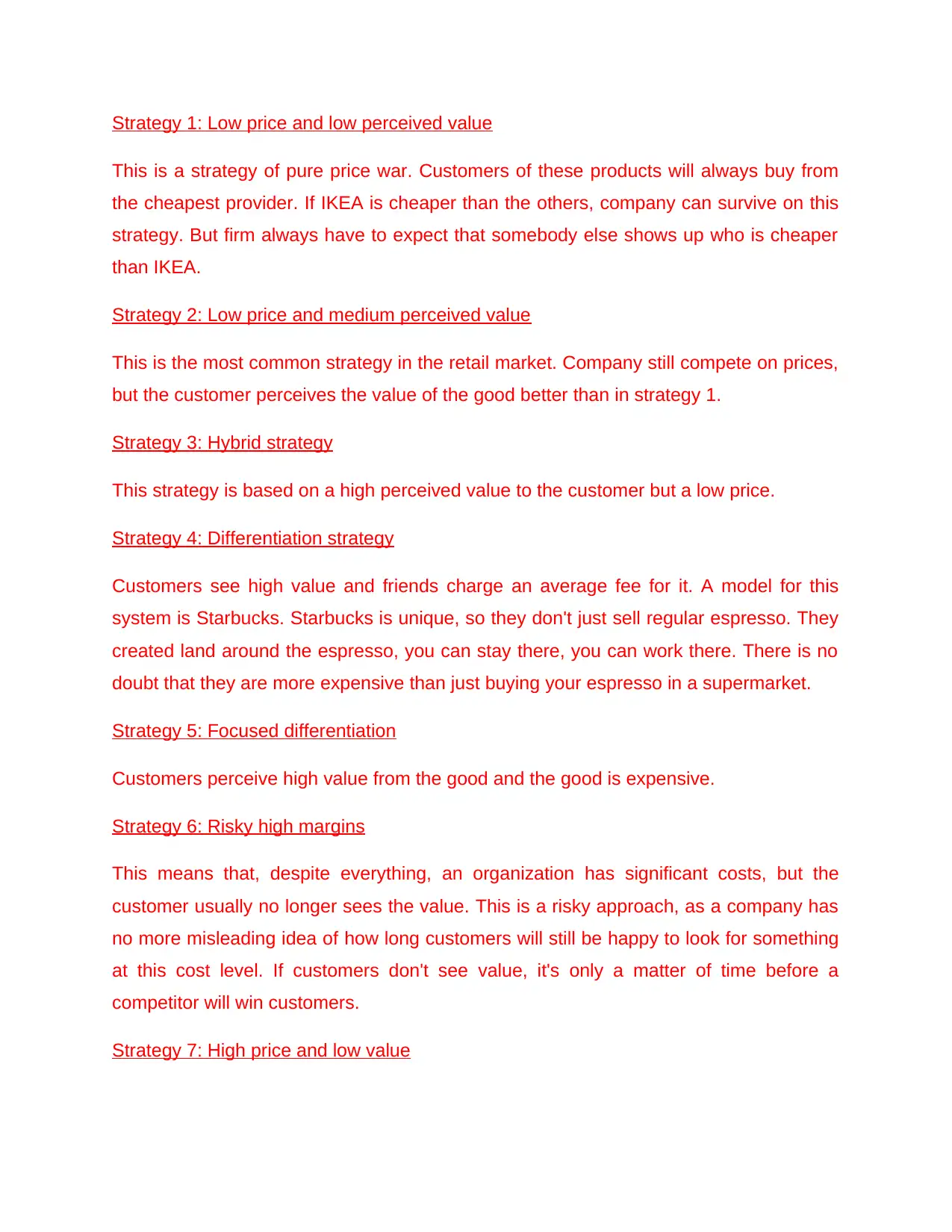
Strategy 1: Low price and low perceived value
This is a strategy of pure price war. Customers of these products will always buy from
the cheapest provider. If IKEA is cheaper than the others, company can survive on this
strategy. But firm always have to expect that somebody else shows up who is cheaper
than IKEA.
Strategy 2: Low price and medium perceived value
This is the most common strategy in the retail market. Company still compete on prices,
but the customer perceives the value of the good better than in strategy 1.
Strategy 3: Hybrid strategy
This strategy is based on a high perceived value to the customer but a low price.
Strategy 4: Differentiation strategy
Customers see high value and friends charge an average fee for it. A model for this
system is Starbucks. Starbucks is unique, so they don't just sell regular espresso. They
created land around the espresso, you can stay there, you can work there. There is no
doubt that they are more expensive than just buying your espresso in a supermarket.
Strategy 5: Focused differentiation
Customers perceive high value from the good and the good is expensive.
Strategy 6: Risky high margins
This means that, despite everything, an organization has significant costs, but the
customer usually no longer sees the value. This is a risky approach, as a company has
no more misleading idea of how long customers will still be happy to look for something
at this cost level. If customers don't see value, it's only a matter of time before a
competitor will win customers.
Strategy 7: High price and low value
This is a strategy of pure price war. Customers of these products will always buy from
the cheapest provider. If IKEA is cheaper than the others, company can survive on this
strategy. But firm always have to expect that somebody else shows up who is cheaper
than IKEA.
Strategy 2: Low price and medium perceived value
This is the most common strategy in the retail market. Company still compete on prices,
but the customer perceives the value of the good better than in strategy 1.
Strategy 3: Hybrid strategy
This strategy is based on a high perceived value to the customer but a low price.
Strategy 4: Differentiation strategy
Customers see high value and friends charge an average fee for it. A model for this
system is Starbucks. Starbucks is unique, so they don't just sell regular espresso. They
created land around the espresso, you can stay there, you can work there. There is no
doubt that they are more expensive than just buying your espresso in a supermarket.
Strategy 5: Focused differentiation
Customers perceive high value from the good and the good is expensive.
Strategy 6: Risky high margins
This means that, despite everything, an organization has significant costs, but the
customer usually no longer sees the value. This is a risky approach, as a company has
no more misleading idea of how long customers will still be happy to look for something
at this cost level. If customers don't see value, it's only a matter of time before a
competitor will win customers.
Strategy 7: High price and low value
Paraphrase This Document
Need a fresh take? Get an instant paraphrase of this document with our AI Paraphraser
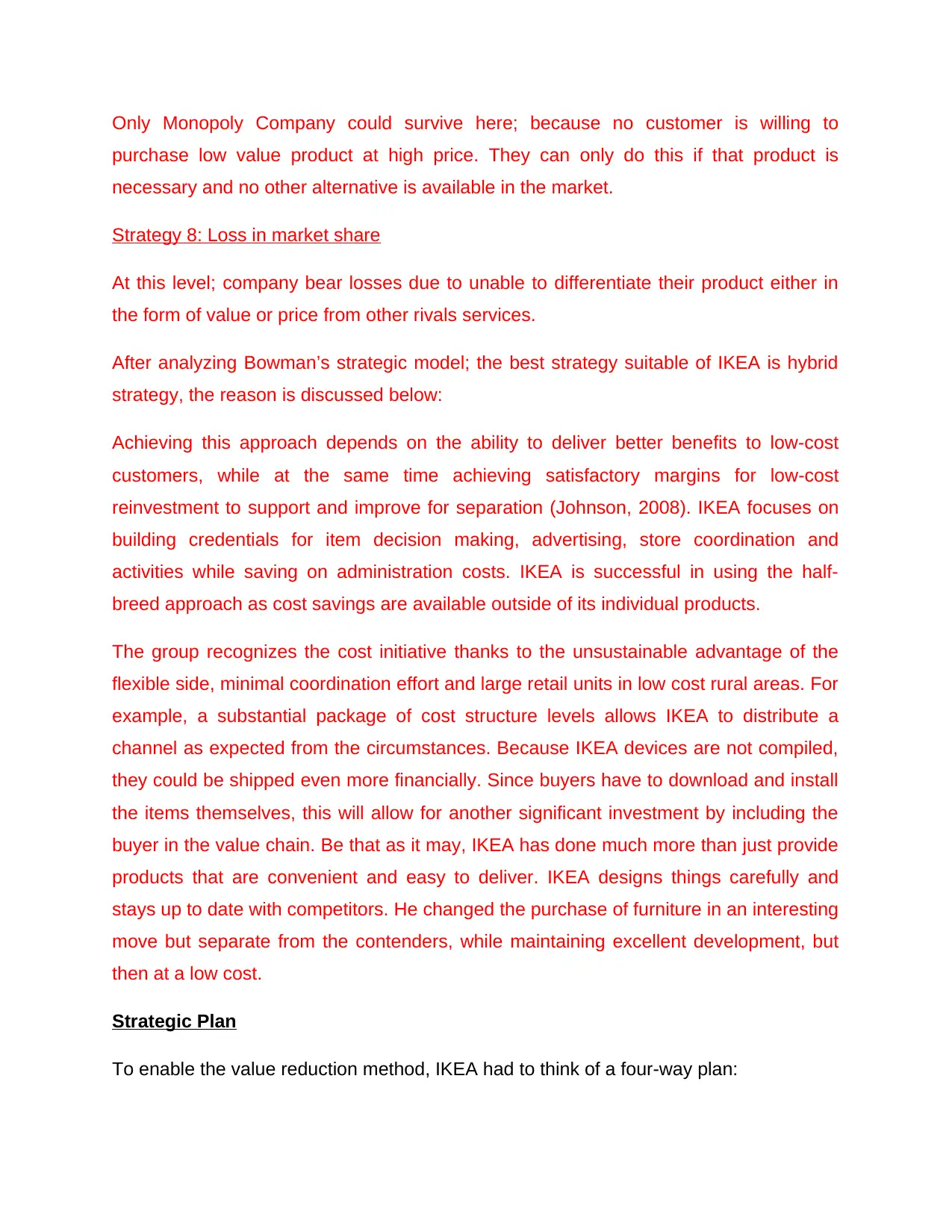
Only Monopoly Company could survive here; because no customer is willing to
purchase low value product at high price. They can only do this if that product is
necessary and no other alternative is available in the market.
Strategy 8: Loss in market share
At this level; company bear losses due to unable to differentiate their product either in
the form of value or price from other rivals services.
After analyzing Bowman’s strategic model; the best strategy suitable of IKEA is hybrid
strategy, the reason is discussed below:
Achieving this approach depends on the ability to deliver better benefits to low-cost
customers, while at the same time achieving satisfactory margins for low-cost
reinvestment to support and improve for separation (Johnson, 2008). IKEA focuses on
building credentials for item decision making, advertising, store coordination and
activities while saving on administration costs. IKEA is successful in using the half-
breed approach as cost savings are available outside of its individual products.
The group recognizes the cost initiative thanks to the unsustainable advantage of the
flexible side, minimal coordination effort and large retail units in low cost rural areas. For
example, a substantial package of cost structure levels allows IKEA to distribute a
channel as expected from the circumstances. Because IKEA devices are not compiled,
they could be shipped even more financially. Since buyers have to download and install
the items themselves, this will allow for another significant investment by including the
buyer in the value chain. Be that as it may, IKEA has done much more than just provide
products that are convenient and easy to deliver. IKEA designs things carefully and
stays up to date with competitors. He changed the purchase of furniture in an interesting
move but separate from the contenders, while maintaining excellent development, but
then at a low cost.
Strategic Plan
To enable the value reduction method, IKEA had to think of a four-way plan:
purchase low value product at high price. They can only do this if that product is
necessary and no other alternative is available in the market.
Strategy 8: Loss in market share
At this level; company bear losses due to unable to differentiate their product either in
the form of value or price from other rivals services.
After analyzing Bowman’s strategic model; the best strategy suitable of IKEA is hybrid
strategy, the reason is discussed below:
Achieving this approach depends on the ability to deliver better benefits to low-cost
customers, while at the same time achieving satisfactory margins for low-cost
reinvestment to support and improve for separation (Johnson, 2008). IKEA focuses on
building credentials for item decision making, advertising, store coordination and
activities while saving on administration costs. IKEA is successful in using the half-
breed approach as cost savings are available outside of its individual products.
The group recognizes the cost initiative thanks to the unsustainable advantage of the
flexible side, minimal coordination effort and large retail units in low cost rural areas. For
example, a substantial package of cost structure levels allows IKEA to distribute a
channel as expected from the circumstances. Because IKEA devices are not compiled,
they could be shipped even more financially. Since buyers have to download and install
the items themselves, this will allow for another significant investment by including the
buyer in the value chain. Be that as it may, IKEA has done much more than just provide
products that are convenient and easy to deliver. IKEA designs things carefully and
stays up to date with competitors. He changed the purchase of furniture in an interesting
move but separate from the contenders, while maintaining excellent development, but
then at a low cost.
Strategic Plan
To enable the value reduction method, IKEA had to think of a four-way plan:
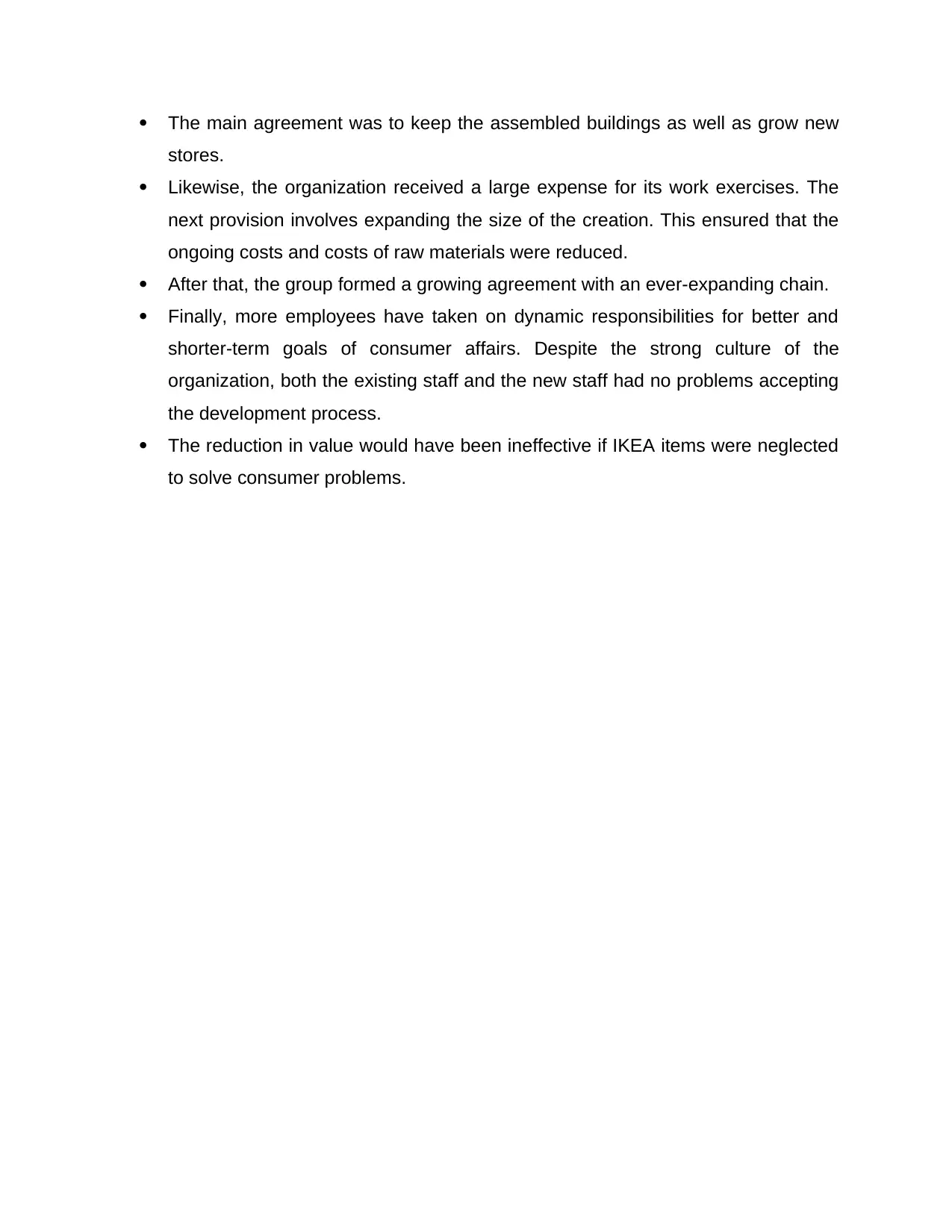
The main agreement was to keep the assembled buildings as well as grow new
stores.
Likewise, the organization received a large expense for its work exercises. The
next provision involves expanding the size of the creation. This ensured that the
ongoing costs and costs of raw materials were reduced.
After that, the group formed a growing agreement with an ever-expanding chain.
Finally, more employees have taken on dynamic responsibilities for better and
shorter-term goals of consumer affairs. Despite the strong culture of the
organization, both the existing staff and the new staff had no problems accepting
the development process.
The reduction in value would have been ineffective if IKEA items were neglected
to solve consumer problems.
stores.
Likewise, the organization received a large expense for its work exercises. The
next provision involves expanding the size of the creation. This ensured that the
ongoing costs and costs of raw materials were reduced.
After that, the group formed a growing agreement with an ever-expanding chain.
Finally, more employees have taken on dynamic responsibilities for better and
shorter-term goals of consumer affairs. Despite the strong culture of the
organization, both the existing staff and the new staff had no problems accepting
the development process.
The reduction in value would have been ineffective if IKEA items were neglected
to solve consumer problems.
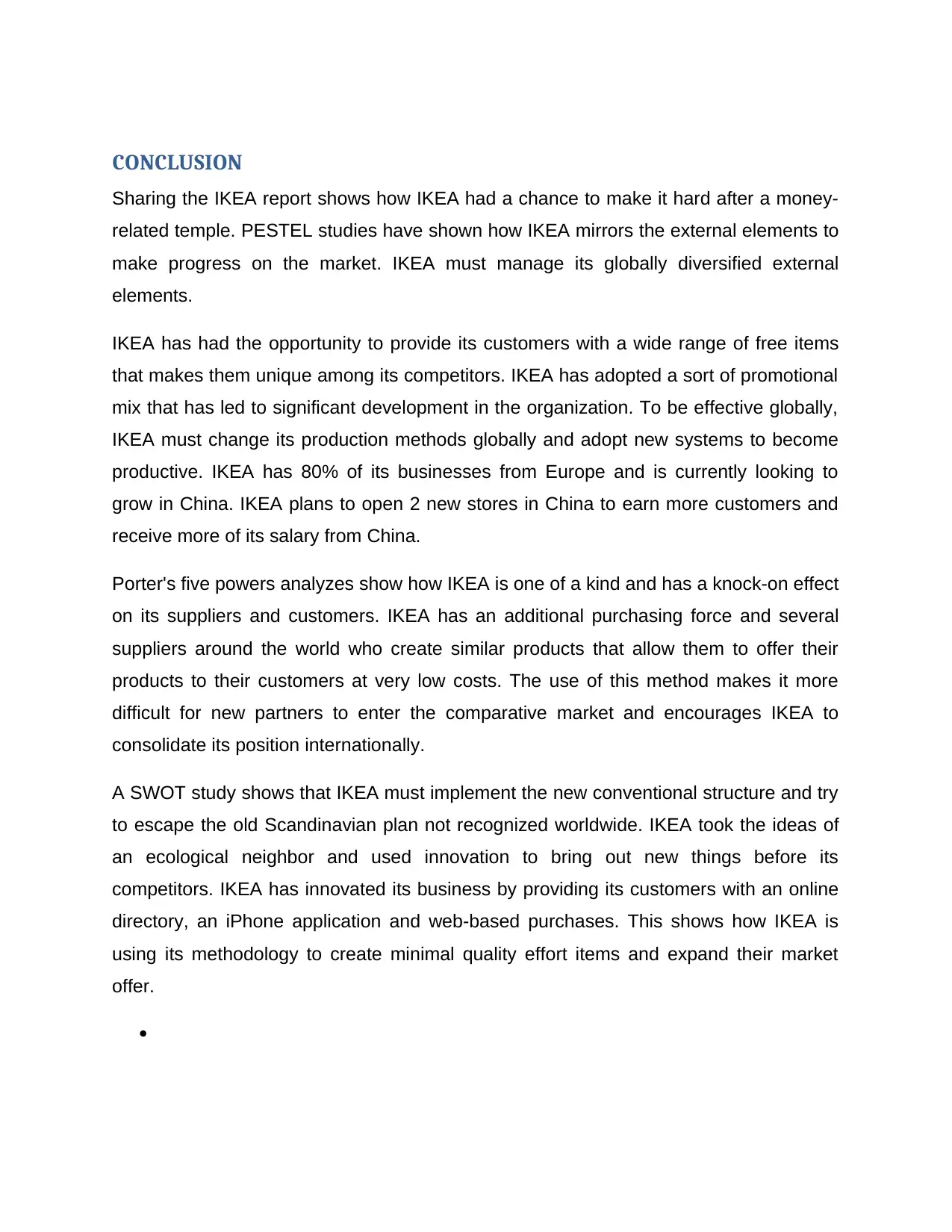
CONCLUSION
Sharing the IKEA report shows how IKEA had a chance to make it hard after a money-
related temple. PESTEL studies have shown how IKEA mirrors the external elements to
make progress on the market. IKEA must manage its globally diversified external
elements.
IKEA has had the opportunity to provide its customers with a wide range of free items
that makes them unique among its competitors. IKEA has adopted a sort of promotional
mix that has led to significant development in the organization. To be effective globally,
IKEA must change its production methods globally and adopt new systems to become
productive. IKEA has 80% of its businesses from Europe and is currently looking to
grow in China. IKEA plans to open 2 new stores in China to earn more customers and
receive more of its salary from China.
Porter's five powers analyzes show how IKEA is one of a kind and has a knock-on effect
on its suppliers and customers. IKEA has an additional purchasing force and several
suppliers around the world who create similar products that allow them to offer their
products to their customers at very low costs. The use of this method makes it more
difficult for new partners to enter the comparative market and encourages IKEA to
consolidate its position internationally.
A SWOT study shows that IKEA must implement the new conventional structure and try
to escape the old Scandinavian plan not recognized worldwide. IKEA took the ideas of
an ecological neighbor and used innovation to bring out new things before its
competitors. IKEA has innovated its business by providing its customers with an online
directory, an iPhone application and web-based purchases. This shows how IKEA is
using its methodology to create minimal quality effort items and expand their market
offer.
Sharing the IKEA report shows how IKEA had a chance to make it hard after a money-
related temple. PESTEL studies have shown how IKEA mirrors the external elements to
make progress on the market. IKEA must manage its globally diversified external
elements.
IKEA has had the opportunity to provide its customers with a wide range of free items
that makes them unique among its competitors. IKEA has adopted a sort of promotional
mix that has led to significant development in the organization. To be effective globally,
IKEA must change its production methods globally and adopt new systems to become
productive. IKEA has 80% of its businesses from Europe and is currently looking to
grow in China. IKEA plans to open 2 new stores in China to earn more customers and
receive more of its salary from China.
Porter's five powers analyzes show how IKEA is one of a kind and has a knock-on effect
on its suppliers and customers. IKEA has an additional purchasing force and several
suppliers around the world who create similar products that allow them to offer their
products to their customers at very low costs. The use of this method makes it more
difficult for new partners to enter the comparative market and encourages IKEA to
consolidate its position internationally.
A SWOT study shows that IKEA must implement the new conventional structure and try
to escape the old Scandinavian plan not recognized worldwide. IKEA took the ideas of
an ecological neighbor and used innovation to bring out new things before its
competitors. IKEA has innovated its business by providing its customers with an online
directory, an iPhone application and web-based purchases. This shows how IKEA is
using its methodology to create minimal quality effort items and expand their market
offer.
Secure Best Marks with AI Grader
Need help grading? Try our AI Grader for instant feedback on your assignments.
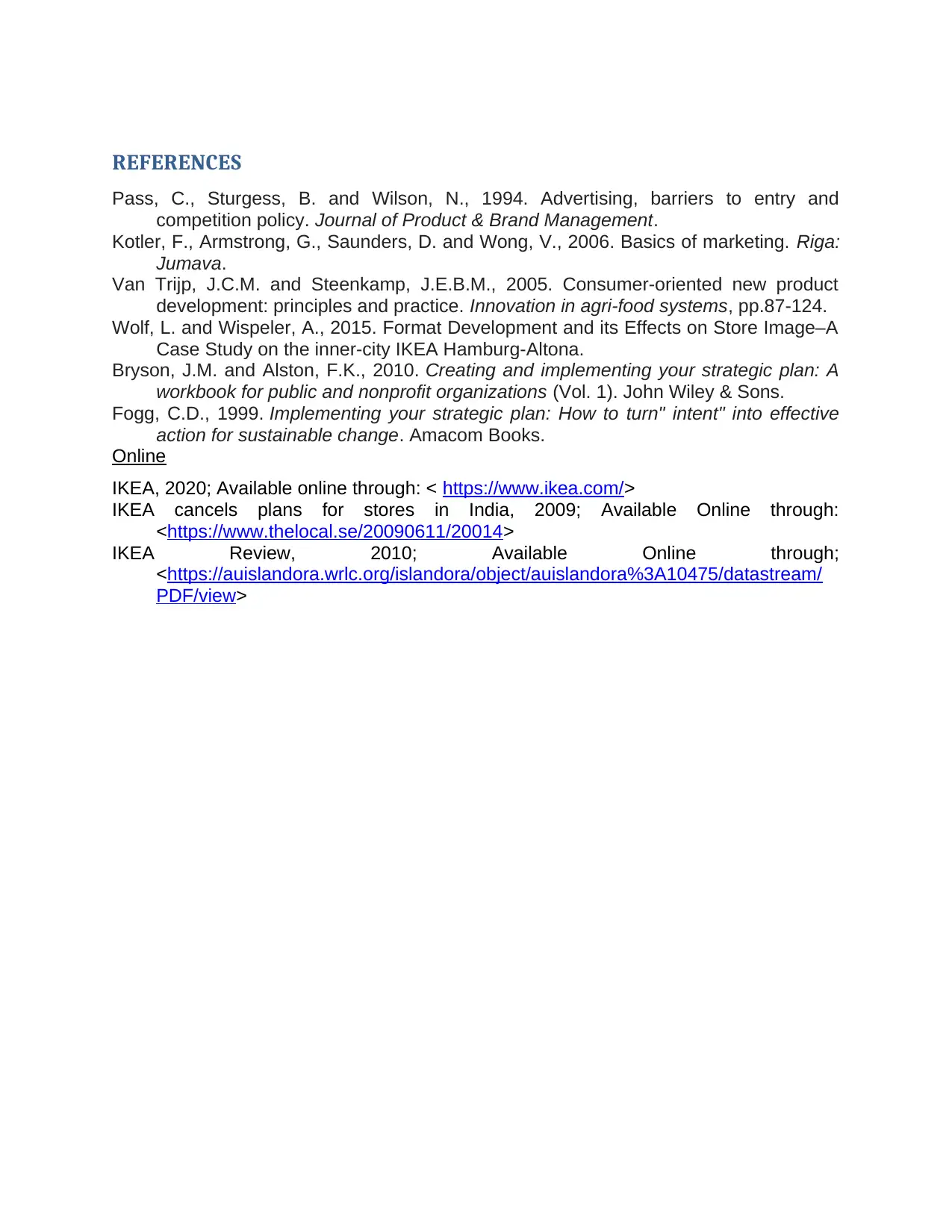
REFERENCES
Pass, C., Sturgess, B. and Wilson, N., 1994. Advertising, barriers to entry and
competition policy. Journal of Product & Brand Management.
Kotler, F., Armstrong, G., Saunders, D. and Wong, V., 2006. Basics of marketing. Riga:
Jumava.
Van Trijp, J.C.M. and Steenkamp, J.E.B.M., 2005. Consumer-oriented new product
development: principles and practice. Innovation in agri-food systems, pp.87-124.
Wolf, L. and Wispeler, A., 2015. Format Development and its Effects on Store Image–A
Case Study on the inner-city IKEA Hamburg-Altona.
Bryson, J.M. and Alston, F.K., 2010. Creating and implementing your strategic plan: A
workbook for public and nonprofit organizations (Vol. 1). John Wiley & Sons.
Fogg, C.D., 1999. Implementing your strategic plan: How to turn" intent" into effective
action for sustainable change. Amacom Books.
Online
IKEA, 2020; Available online through: < https://www.ikea.com/>
IKEA cancels plans for stores in India, 2009; Available Online through:
<https://www.thelocal.se/20090611/20014>
IKEA Review, 2010; Available Online through;
<https://auislandora.wrlc.org/islandora/object/auislandora%3A10475/datastream/
PDF/view>
Pass, C., Sturgess, B. and Wilson, N., 1994. Advertising, barriers to entry and
competition policy. Journal of Product & Brand Management.
Kotler, F., Armstrong, G., Saunders, D. and Wong, V., 2006. Basics of marketing. Riga:
Jumava.
Van Trijp, J.C.M. and Steenkamp, J.E.B.M., 2005. Consumer-oriented new product
development: principles and practice. Innovation in agri-food systems, pp.87-124.
Wolf, L. and Wispeler, A., 2015. Format Development and its Effects on Store Image–A
Case Study on the inner-city IKEA Hamburg-Altona.
Bryson, J.M. and Alston, F.K., 2010. Creating and implementing your strategic plan: A
workbook for public and nonprofit organizations (Vol. 1). John Wiley & Sons.
Fogg, C.D., 1999. Implementing your strategic plan: How to turn" intent" into effective
action for sustainable change. Amacom Books.
Online
IKEA, 2020; Available online through: < https://www.ikea.com/>
IKEA cancels plans for stores in India, 2009; Available Online through:
<https://www.thelocal.se/20090611/20014>
IKEA Review, 2010; Available Online through;
<https://auislandora.wrlc.org/islandora/object/auislandora%3A10475/datastream/
PDF/view>
1 out of 23
Related Documents
Your All-in-One AI-Powered Toolkit for Academic Success.
+13062052269
info@desklib.com
Available 24*7 on WhatsApp / Email
![[object Object]](/_next/static/media/star-bottom.7253800d.svg)
Unlock your academic potential
© 2024 | Zucol Services PVT LTD | All rights reserved.





